S.W. O'Connell's Blog, page 8
April 30, 2020
The King’s Engineer
The struggle for North America during the 18th century featured an array of gallant and industrious men from frontier woodsmen, hearty yeoman farmers, professional soldiers, wily politicians as well as the merchants, tradesmen and famers whose industry financed and supplied them. There is another category, one critical to the building of empire, especially an empire carved from wilderness – the engineer. Skilled at planning, surveying, and map-making, engineers connected people to the land. And warfare in North America, was about land and shaped by the land. Geography drives history.
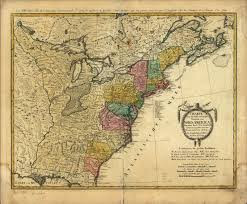 Montresor would spend most of his
Montresor would spend most of hismilitary career in North America
Servant of Empire
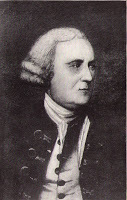 James Montresor
James MontresorOne such engineer was John Montresor. Montresor was the son of a British officer of French Huguenot roots, James Gabriel Montresor. John was born in 1736 on the key British base at Gibraltar. The senior Montresor was chief engineer at the time. John spent four years (1746-1750) at Westminster school in England. When he returned to Gibraltar, his father instructed him in the principles of engineering and took him to North America when he was named chief engineer for General John Braddock.
Fighting the French and Indians
 General Braddock
General BraddockJohn Montresor was commissioned an ensign in the 48th Regiment of Foot in March 1755 and was appointed engineer in June. The Braddock campaign against Fort Duquesne is storied (see Yankee Doodle Spies Blog Post: Road of Destruction). The defeat of Braddock’s column by native warriors and French soldiers at the battle of the Monongahela, and the Braddock's death had a chilling affect on the British effort. It also made a hero out of young George Washington. Young ensign Montresor saw action in that battle and was himself wounded during the massacre.
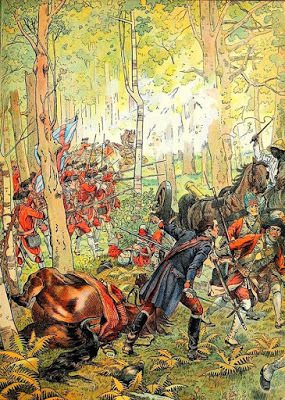 Montresor was wounded at
Montresor was wounded atthe Battle of the Monongahela
Promoted to lieutenant, Montresor was sent to New York, the main theater against the French. His engineering skills were honed by his construction of Fort Edward. In 1757 he served Lord Loudoun (British commander in N.A.) in a failed campaign against the mighty French bastion at Louisbourg. The failure did not put a dent on his career.
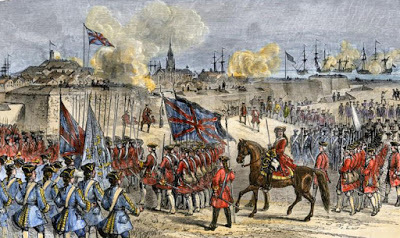 Montresor's engineering skills helped
Montresor's engineering skills helpedsecure the fall of Louisbourg
The following year John received his commission as practitioner engineer and gave up his commission in the infantry. From a career perspective, he took the road least taken. Engineers were critical in modern warfare but rising above major was rare and certainly no path to general. But then as today, engineers favor the work over advancement. That summer he joined General Jeffery Amherst’s army in another go at Louisbourg. As an engineer, he played a key role in the siege of the fortress. Montresor remained in Nova Scotia and in March 1759 performed a reconnaissance around the Bras d’Or lakes.
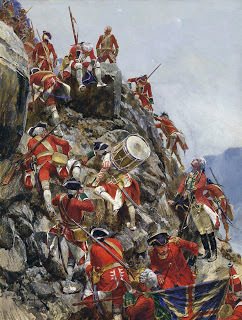 British infantry scaling cliffs to
British infantry scaling cliffs toreach the Plain of Abraham during the
Battle for Quebec
Montresor’s skills were noted, and he was soon sent to join the army forming under General Wolfe in its successful but tragic (commanders on both sides mortally wounded) campaign against the capital of French North America, Quebec.
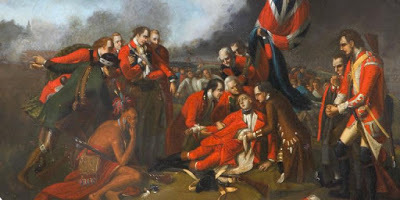 British General Wolfe died in battle for Quebec,
British General Wolfe died in battle for Quebec, his opponent General Montcalm was also mortally wounded
Carving out a New Land
Montresor remained in North America after the Treaty of Paris ended the war in 1763. A rugged new world needed to be mapped and infratstucture of all types need planning and construction - especially forts to protect the newly aquired empire. What better place for an engineer? He stayed with the occupying army, serving newly appointed governor, General James Murray in a series of mapping expeditions of the newly conquered territory. Probably the most important of these was supporting Murray's mapping of the St. Lawrence River. But Montresor was also engaged in constructing forts in the new dominion. Montresor's French language skills also saw him in a pacification role, disarming local militias and ensuring the loyalty of the king’s new subjects.He also found time to explore the wilderness between Quebec and the Kennebec River (Maine). Ironically, his written record would be used by Colonel Benedict Arnold in his campaign against Canada in 1775.
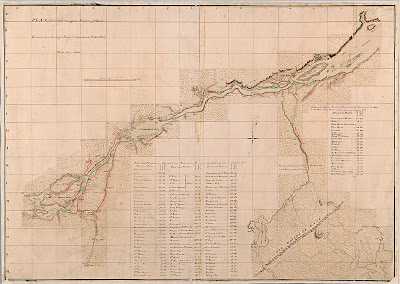 John Murray commissioned a seminal
John Murray commissioned a seminalmap of the Saint Lawrence River
Pontiac's War
In 1763, Montresor was stationed in New York, but the eruption of Pontiac’s Indian rebellion saw him back in Canada. There, General Jeffery Amherst tapped him for a dangerous covert mission: cross hundreds of miles of hostile wilderness to deliver dispatches to the commander of the besieged garrison at Detroit. His knowledge of the land made him the perfect choice to serve as chief engineer for the relief column sent to Detroit the following year. But before heading west, Montresor took the time to constructed forts along the Niagara River.
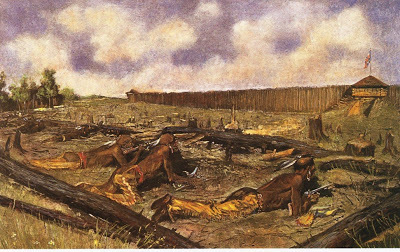 Montresor braved hostile Indian terrotory
Montresor braved hostile Indian terrotoryto complete his mission to beleagured Detriot
On his return from the Detroit expedition, Montressor was shipwrecked on Lake Erie. Switching to another boat, geek-like the engineer Montressor took the time on his way back to practice a little hydrography, exploring the depth and width of several of the lake’s tributaries along the way.
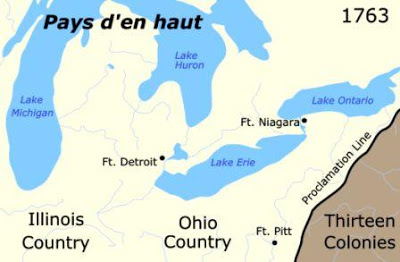 Montresor made lemonade from lemons
Montresor made lemonade from lemonsusing even a shipwreck to explore Lake Erie
Pause and a Promotion
The arrow of Eros struck him while in New York. Montresor married an American woman, Frances Tucker, in New York City on 1 March 1764. It must have been a good match because they wound up raising six children.
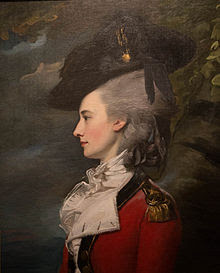 Frances (nee Tucker) Montressor decked out
Frances (nee Tucker) Montressor decked outas Brisih officer.
Stationed at Fort George (formerly Fort William Henry) in 1765, he saw the beginnings of the political movement that would eventually lead to insurgency and open rebellion with the rioting in Albany and New York City in in protest to the Stamp Act. Montresor made a voyage to England in 1766. When he returned to America, Montresor was a captain-lieutenant and master of the Ordnance for America. As such, he spent quite some time in the mid-Atlantic region, constructing forts, primarily along waterways such as Boston, New York and Philadelphia. One significant fort guarding Philadelphia on Mud Island would bear his name and be the venue of bloody combat a few years later.
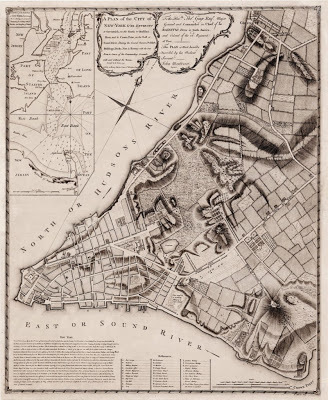 Montresor drew up one of the earlyiest
Montresor drew up one of the earlyiestprofessional maps of The Big Apple
During that inter-war period he managed to find time to survey the boundary between New York and New Jersey and built or upgraded forts and military bases. During his time in New York, he purchased an island in New York’s East River. It was named Montressor’s Island after him but New Yorkers know it as Randall’s Island. Montresor oversaw the devlopment of a map of New York City during his time there.
Chief Engineer
In April 1775 he was in Boston when the outbreak of open war in North America once again changed the trajectory of his career. He was now thrust into the de facto chief engineer for the British forces in America. This resulted in a promotion to captain in January 1776.
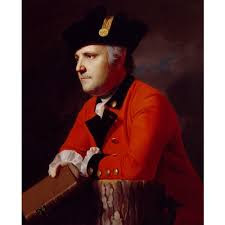 Captain John Montresor
Captain John MontresorFor a while, he seemed to be the Forrest Gump of the British effort – seemingly everywhere and meeting everyone. He secured river crossings for the march on Lexington and Concord and helped relieve the British column skulking back to Boston after being stung by an aroused populace. His engineering skills were put to work in the defense of Boston and he was one of the last officers to leave the beseiged city.
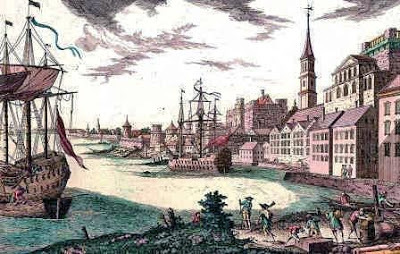 Boston
BostonAs chief engineer during the Battle of Long Island in August 1776, he would have planned the siege works to blast Washington’s beleaguered force out of Brooklyn. Montresor witnessed the execution of Nathan Hale in New York City the following month. He allegedly gave succor to Hale, letting him use his office to write final letters to his family. The British picked him to cross rebel lines to inform the Continental Army of the execution, which is said to have moved him greatly.
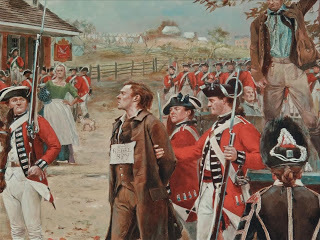 Montresor witnessed Nathan Hale's Execution
Montresor witnessed Nathan Hale's ExecutionHe gave up his post as chief engineer and served as General William Howe’s aide de camp for a time, but Montressor was later reinstated as chief engineer. When the campaign for Philadelphia was launched in 1777, he was in the thick of operations. He fought during the forage war in New Jersey. He also served at the battle of Brandywine later that year, and accompanied the army to Philadelphia where he rebuilt the garrison's fortifications and later launched the savage series of attacks that destroyed his former Mud Island defenses, which ironically included Fort Mifflin, the fort that once bore his name.
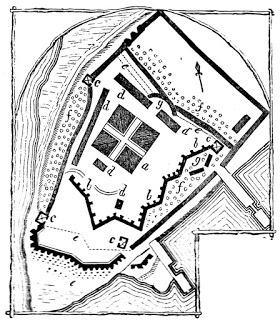 Plans for Fort Mifflin, once known as Fort Montresor
Plans for Fort Mifflin, once known as Fort MontresorWith the British occupation of Philadelphia, he directed the construction of new defenses for the American capital. Montresor also planned the construction of pontoon bridge at Gray's Ferry on the Schuylkill River.
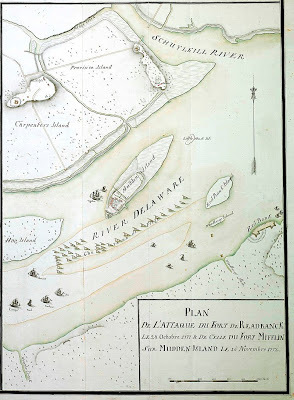 Fort Montressor was renamed Fort Mifflin,
Fort Montressor was renamed Fort Mifflin,giving the King's Engineer the honor of attacking
his own creation
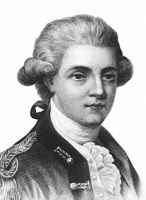 Major AndreA Rapid Closure
Major AndreA Rapid ClosureAs the British occupation dragged on, the commander in chief, sir William Howe was recalled to England. Montresor, Howe’s former aide, helped Major John Andre (a future spymaster) plan a massive and extravagant farewell celebration called the Meschianza.
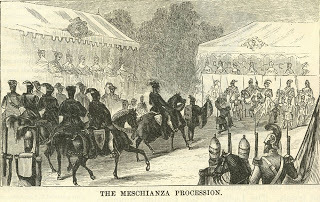 The Meschianza included parades
The Meschianza included paradesThis was a series of lavish events with shows, parades, musical concerts and displays, as well as banquets and a ball culminating in a firework show worthy of a Broadway or Hollywood impresario.
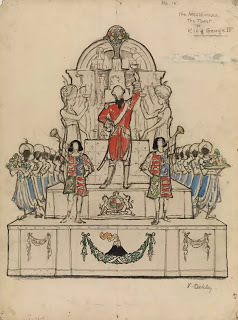 Major Andre arranging a Meschianza display
Major Andre arranging a Meschianza displaywith and exotic oriental theme
The spring of 1778 brought a new commander in chief, General Henry Clinton, and at some point that year Montresor was superseded as chief engineer. He returned to England in October where he retired from the army, ending more than twenty years’ service to king and country, albeit a country he spent little time in. But the king’s engineer did not have good time of it in post-army life. Montresor was not happy with his treatment by the army, feeling pique at not receiving a promotion. He blamed the Ordnance office for this and felt his talents and record were unappreciated and unrewarded.
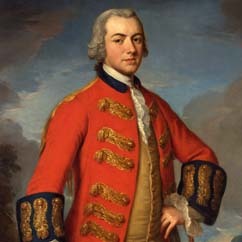 Sir Henry Clinton replaced Howe
Sir Henry Clinton replaced HoweMontresor would follow later that year
It is unclear exactly why he left so abruptly. Perhaps he did not get along with Clinton because of his close association with Howe. But it might have had to do with something more basic – money. There were suspicions he misused his wide discretion in the exercise of his role as engineer. In that position, he controlled considerable funds for the procurement of the equipment, material and manpower for construction projects. The lack of good accounting practices and financial controls may have enabled him to amass a considerable sum of money for his own pockets.
Montresor was a very exacting and demanding engieer, frequentl requisitioning the best materials for his projects. During the construction of the forts around Philadelphia he submitted invoices for extensive materials ultimately denied by the colonial governement. His demading ways may have also crossed him with General Murray at Quebec, and perhaps Henry Clinton.
A Desperate End
In 1782, his accounts went through scrupulous audit, resulting in him being held liable for £50,000 out some £250,000 in expenses he claimed as chief engineer in America. Despite strenuous appeals by Montresor, he lost. The Exchequer went after his estate, seizing his London residence and property in Kent, ultimately recouping £48,000. Despite his service, Montresor eventually ended up in Maidstone prison, a debtors’ prison, where he tragically died on 26 June 1799.
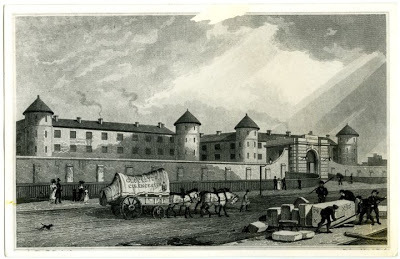 Debtor's Prisons were the final destination
Debtor's Prisons were the final destinationof the bancrupt in the 18th century
Legacy
Two of Montresor’s sons received commissions in the British Army, despite their father’s difficulties. So the family tradition of service to king and country continued.One is struck by the tremendous contribution Montresor made to the British success in North America in three wars and an inter-war period of consolidation, yet he receives little mention.
This likely was in part due to the relative low regard for the more technical branches in an army drenched with arcane tradition and social stratification. Had he been a man of birth and not merit, or a member of a prestigious regiment, his transgressions might have been overlooked. And of course, as a descendant of French Hugenouts, he was not English. Just saying. This is not to rationalize sloppy accounting or look the other way at embezzlement, merely a period social observation.
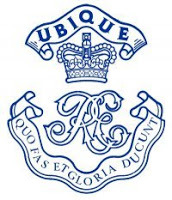 Cypher later adopted by
Cypher later adopted bythe Royal Engineers
Montresor, in engineer style, kept a scrupulous journal that pointed out minutiae in day to day operations and conditions. Exact distances and measures were noted. Daily temperatures as well. Those parts of his journal that survive show a man with great attention to detail, but his journal also reveals a bit of hubris as well. Perhaps that hubris led to friction with peers and superiors, and something worse. We will never know.
 Surviving Montresor journals
Surviving Montresor journalsprovide a n insight into the man and his times
Published on April 30, 2020 11:04
March 29, 2020
Yankee Doodle Disease
An Age-Old Problem
Throughout the course of history, the bane of most armies was not enemy swords, spears, bayonets, bombs or bullets. Up until at least the second world war, disease and infection killed or disabled more men than battle. Even with today’s Corona Virus Pandemic, there are reports of infections in the military at much higher rates than the regular population. Like so many people around the world, I have been sitting at home and watching a global epidemiological disaster unfold, while trying to ignore the inconvenient fact that I am at the center of it. As are we all. This led me, naturally, to ruminate on the topic in terms of the times of the Yankee Doodle Spies.
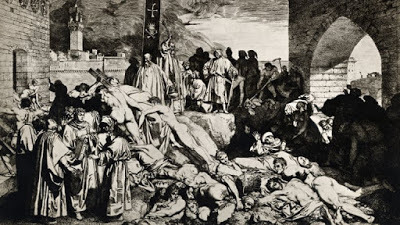 The Black Death wreaked havoc and terrorized
The Black Death wreaked havoc and terrorizedover centuries of outbreaks
Disease in War
In a strange irony, war brings people together. Not just the face to face clash of foes but the necessary formation of close—knit units who are thrown together to eat, sleep, train and fight. Camps and garrisons become breeding grounds, especially when hygiene is not maintained. It is that very closeness that makes them so vulnerable when various outbreaks occur.
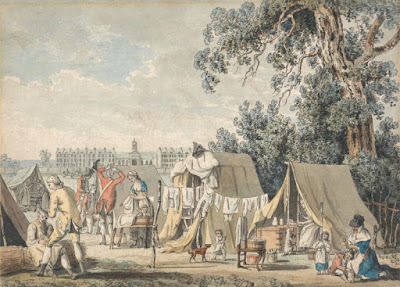 Gathering of soldiers in military camps was
Gathering of soldiers in military camps wasground-zero for the spread of disease
Epidemics have weakened armies, sometimes rendering them unfit for combat operations, outbreaks have frozen military operations, and of course there is the effect on civilian populations armies come in contact with. Geography plays a role, with both bitter cold and steaming hot climates playing a role in the spread of illness. Swamps, littorals and cities all present environments supportive of various types of disease. And of course, the transports of armies, placing soldiers in strange new lands where they can encounter new diseases and bring their own to impact the locals.
Yankee Doodle Disease
The American Revolution in many ways exemplifies all of these factors. Men from farms and forests thrown together with men from towns and seaports. Undernourished, often poorly dressed and exposed to the elements, these men (and women) often faced a foe worse than any redcoat or Hessian. A foe invisible to the naked eye and who, in most cases, the best medicine of the age did not comprehend and could not combat. Simply put, they faced an array of germs that packed a punch as bad as any .69-inch musket ball or 17-inch bayonet. Diseases such as smallpox, dysentery, and malaria, were commonly suffered by American and British and Hessian soldiers alike. They were an enemy that did not choose sides. Given the close-quarters environments of 18thcentury encampments these diseases would spread through a camp like a windstorm across the high plains.
 Disease killed more men than
Disease killed more men thanmusket balls or bayonets
A Different Kind of Battle
The soldier of the American Revolution faced highly professional armies equipped with the best weapons of the late 18thcentury. But if musket, cannon did kill the soldier, the state-of-the-art treatment for a wound or illness might. Data indicates the typical combatant stood a 98% chance of surviving battle, but around a 75% chance to walk (or limp) from the hospital. Unsanitary conditions, lack of knowledge of vectors, lack of practical remedies combined in a tragically unfair fight for the wounded or sick patriot. No antibiotics, but plenty of bleeding. No anesthetic, but plenty of bullets to bite. And if things really looked serious? Not to worry, there were an abundance of trained surgeons and their assistants who could cut off a limb or bleed the life blood from you.
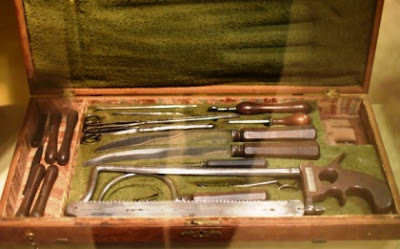 State of the art medical kit of the Rev War
State of the art medical kit of the Rev WarA Different Kind of Surgeon
During the time of the American Revolution, pretty much anyone could claim to be a doctor and begin practicing medicine as long as they spent a few years of apprenticing with another doctor. Very few were trained surgeons from Edinburgh or London. And even if they were, medical science of the day was based on theories (often bogus) not on real scientific knowledge. This was especially true when it came to illness, especially infectious disease. Doctors of the period thought most illness was brought about by “an imbalance of the humors” -- blood, yellow bile, black bile, and phlegm. How to regain the balance in the humors? The typical procedure used was bloodletting or sometimes herbal concoctions to help induce vomiting or bowel movements. Lots of ways to restore the balance.
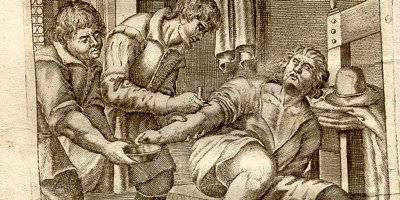 Bleeding was a common treatment for bad humors
Bleeding was a common treatment for bad humorsA Different Kind of Pharmacist
Medicine in the time of the Yankee Doodle Spies was hard to come by. Prior to the war, medicine, like almost everything else, had to come from England. One reason we rebelled. The war broke that supply chain until the French alliance in 1778. A new supply chain from France brought medicine to America. But even when medicine reached the army camps, most were of limited value, if not dangerous. In a medical field that lacked anesthetics, opiates were the go-to painkillers, followed by hard liquor, and the previously mentioned bullet. For various ailments some surgeons used mercury compounds, lavender spirits, and cream of tartar.
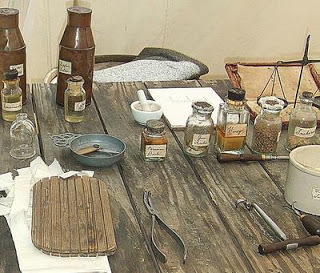 Medicines of the day were, interesting
Medicines of the day were, interestingClimate Change
Disease would strike in any climate. Winter brought seasonal flu and the resultant pneumonia that drowned the soldier in his own lungs. And the years of the American Revolution had some savage winters thanks to a mini-ice age. Many died at Valley Forge, Morristown, Newburgh and other winter cantonments. Summer, especially in the south and in the swamps and low-lying coastal flats, brought the noxious vapors, often malaria but more often the deadly yellow fever. Of course, the vapors, typically called miasmas, were not the vector. Insects provided that. In the case of the latter, the lowly mosquito.
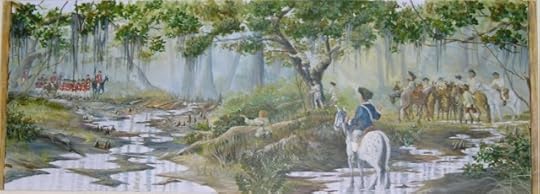 Swamps along the Georgia and Carolina littoral were a breeding ground
Swamps along the Georgia and Carolina littoral were a breeding ground for the"noxious and bilious vapors"that plagued both sides
The war in the south was impacted greatly by disease. It was one of the biggest concerns of the British high command, who had experience sending soldiers into warmer climes. The outbreak of disease chronically weakened General Charles Cornwallis’s army in the Carolinas, impacting battles and strategy. At critical junctures, key lieutenants got ill, as did Cornwallis. When he finally had a reasonably fit and equipped force in hand at Wilmington, he decided to move north to Yorktown and not back into South Carolina in part to get his army into a healthier climate. We know how that turned out.
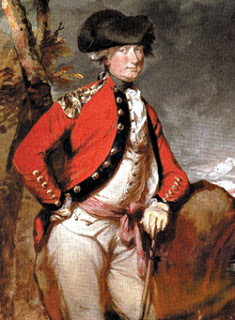 Disease factored into the strategy
Disease factored into the strategyof Lord Cornwallis, with unpredictable results
Mother of All Maladies
Smallpox was a real killer in the time of the Yankee Doodle Spies. And it could leave permanent scarring when it did not actually kill you. Armies and their camp-followers were very susceptible to the disease and outbreaks threatened both sides. Smallpox in some ways resembles the Corona Virus in its manifestation. It spreads from direct contact, not other vectors such as insects. It can incubate a fortnight before victims are symptomatic. It manifests with some of the similar to Corona and the flu bringing fevers, headaches, and body ache.
But the smallpox piles on with the outbreaks of pustules on the body. Soldiers suffered for about another fortnight before succumbing. It killed one out of three people infected (.3 mortality rate in Dr. Fauci terms) and the survivors take weeks and weeks to recover. Of course, the tell-tale scars make sure you (and those around you) never forget.
The Continental Army suffered outbreaks during the siege of Boston and the defense of New York, again large numbers of soldiers in a relatively confined area. There were two approaches to combating the disease, neither helpful when you are trying to wage a war.
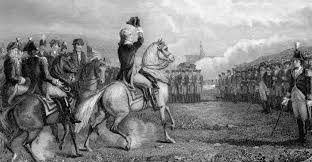 Soldiers from a over a half-dozen states gathered outside
Soldiers from a over a half-dozen states gathered outsideBoston, providing conditions ripe for the spread of disease
Social Distancing
The first was quarantine, the social distancing of the day. Hard to do when men are organized in unit sets, such as companies, regiments and brigades. Harder to do in winter quarters, where men huddled freezing around smokey camp fires and shared common meals together. Meals often sparse and un-nutritious. The Continental Army could not tele-work. Well, at least not for long.
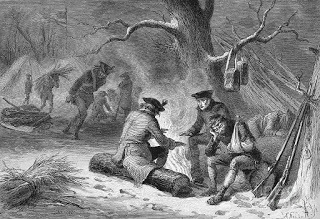 Winter cantonments such as Valley Forge,Morristown
Winter cantonments such as Valley Forge,Morristownand Newburgh offered little chance for social distancing
Variolation
As controversial in the time of the Yankee Doodle Spies as today, the smallpox was one of the few diseases preventable by inoculation, then called variolation. The variolator used a lancet with fresh matter taken from the pustule of someone with active smallpox. The matter was then scraped on the arms or legs of the recipient, or introduced through the nose. There were risks to this, recipients often developed the symptoms like fever and a rash. But fewer people died from variolation than if they had acquired smallpox naturally. In a study conducted during an outbreak in Boston in 1722, those without variolation died at the rate of 14%, the variolated died at 2% (.14 versus .02 in Dr. Fauci terms). This might have been one of the first instances of data in medical science.
Surgeon-in-Chief
In addition to being commander-in-chief and spymaster-in-chief, General George Washington was the final arbiter on the use of medical procedures to battle outbreaks. He himself had a mild version of the smallpox earlier in life during an expedition to the West Indies. Yet military exigencies in 1775 and 1776 precluded him from ordering wide spread variolation. The British, meanwhile, were using it on any recruit coming to America.
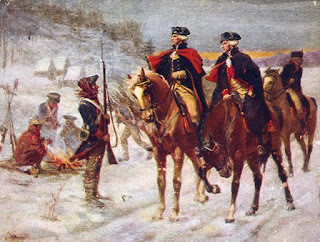 The year 1777 required forced inoculation to
The year 1777 required forced inoculation toprevent the army from wasting away from smallpox
By 1777 the situation changed. A series of outbreaks that year would take as many as 100,00 lives in North America. Only 2.5 million lived in the colonies, not counting the native tribes in the colonies, the Spanish-America and Canada. But a pretty large “numerator” as the good doctor would say. Washington had to take the risk that mass inoculation would not debilitate the Continual Army and finally approved the procedure, beginning with all new recruits. By the following year, however, a considerable number had still somehow avoided the procedure. This time, Washington gave strict instructions that these men would undergo inoculation. Washington made variolation for smallpox "settled science."
Father of Public Health
Just as the ravages of infectious disease helped bring the death knell of the Roman Empire, Medieval Europe and other civilizations, the great outbreaks of smallpox in America during the struggle for independence might well have done what masses of redcoats and Hessians could not do, break the will of the patriots. It is not hyperbole to say that the mass inoculation ordered by Washington saved the army and thus the American cause. And he may be able to add the honorific, the “Father of Public Health” in addition to the “Father of His Country.”
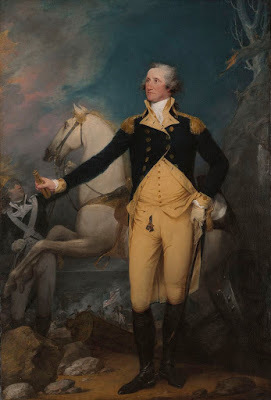 First in War, First in Peace,
First in War, First in Peace,First in Public Health
Published on March 29, 2020 10:45
February 29, 2020
Captain Molly
Female First Patriot
The American War for Independence would not have succeeded without the dedicated efforts of many women, from all walks of life. Besides the obvious morale support women provided the cause, they maintained the farms or ran the shops when the men-folk were with the army or the militia. They raised money and engaged in the day to day commerce that kept the economy going and helped feed the revolution. They organized efforts to sew and knit, providing badly needed garments, blankets and the like for an army poorly served by traditional logistics. Many also followed the gun, joining husbands or sweethearts with the forces as camp-followers. This female first patriot’s service began that way. But it did not end that way. Her name was Mary Chocrane Corbin, and she was indeed, a female bad-ass.
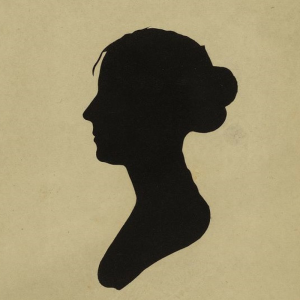 Captain Molly - an original bad-ass
Captain Molly - an original bad-ass
Frontier Orphan
Margaret Chochrane (later changed to Chocran) was born near today’s Chambersburg, Pennsylvania in Franklin County, Pennsylvania, on 12 November, 1751, of Scotch-Irish settlers. Pennsylvania was a battlefront during the French and Indian War, however, and in 1756 and Indian attack changed her life for the worse. In a savage raid so common then, her father was killed and her mother carried off never to be seen again. Margaret escaped but now an orphan, she was raised by an uncle. This was not uncommon in those days. One can only think her hard scrabble youth steeled her for the challenges that lay in store for her.
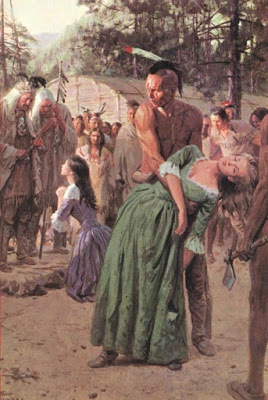 Margaret's mother was carried off in an Indian raid
Margaret's mother was carried off in an Indian raid
Newlywed... New Recruit
In 1772, at the relatively old age of twenty-one, she married John Corbin, a Virginian who came to Pennsylvania during the war and lingered on. In the run up to the War for Independence John Corbin enlisted in Captain Thomas Proctor’s company of the 1st Continental Artillery. Corbin was a matross, a gunner’s assistant in an artillery crew. As a matross, it was John Corbin’s duty to assist the gunner in loading, firing and sponging the guns.
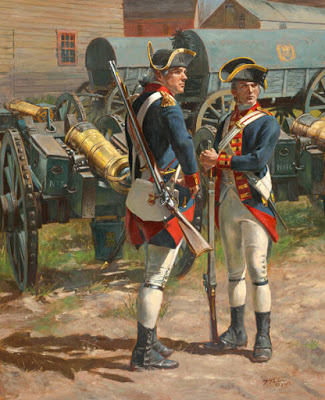 John Corbin served as a matross, assistant gunner
John Corbin served as a matross, assistant gunner
Follow the Army
Like many women of her day, Margaret joined the army with her husband and served his unit as a camp follower. Camp followers were an essential component of 18th century armies, providing essential services such as cooking, washing clothes and blankets, fetching firewood and water. In combat, they often attended the wounded or carried water for the troops. Without the service of these dedicated women, soldiers of the Revolutionary War would have suffered even more than they did. Especially the Americans, whose logistics often lacked.
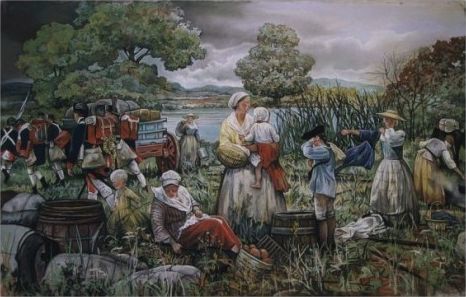 Camp Followers were critical to the armies
Camp Followers were critical to the armies
Active Service
Margaret was with the Continental Army in this capacity at New York in 1776. By November of that year General Washington’s army had been driven from Brooklyn, had abandoned most of Manhattan, and had withdrawn to the Jerseys in the face of overwhelming British land and naval power. On Manhattan, the Continental Army was clinging to a small piece of rock at the northern tip of the island. Fort Washington stood high above the North (Hudson) River and the Harlem River, making it a critical piece of land. On November 16, General William Howe ordered a three-pronged bombardment and assault on Washington’s namesake bastion.
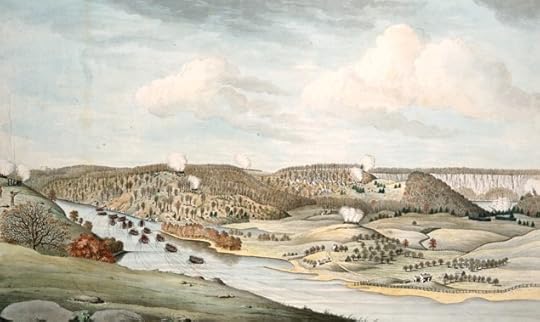 Fort Washington
Fort Washington
Captain Molly
The fort’s defenders put up a desperate fight at first, stymieing the efforts of British and Hessian regulars. But soon the endless pounding of guns and determined assaults took its toll on the outnumbered defenders. John was assisting a gunner until the gunner was killed. At this point he took charge of the gun and Margaret stepped in to assist him. Before long, the intense British fire took him down - John Corbin was killed in combat. Undeterred, his wife now stepped in for him.
Margaret was often reported to have a feisty nature. On this day it would serve the forlorn cause at the fort. With no time to grieve her fallen husband, Margaret sprang into action and began serving one of the guns in his place, personally loading and firing round after round at the attackers. But the British soon trained their guns on the belching American cannon. Before long, Margaret herself was struck by a blast of grapeshot from the HMS Pearl firing from the river below the fort. A swarm of lead balls tore her into shoulder, mangled her chest and lacerated her jaw. Several soldiers carried her to the rear where she received what little treatment they could give.
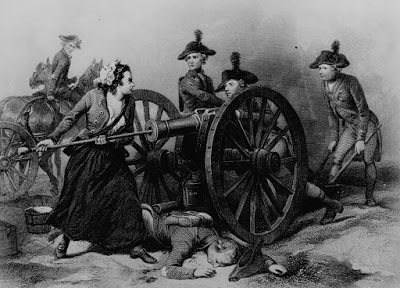 Captain Molly working a cannon at Fort Washington
Captain Molly working a cannon at Fort Washington
Wounded in the Line of Duty
The fort soon surrendered, and thousands of soldiers were marched off to eventual death on prison hulks. But Margaret’s wounds were so severe she was paroled by the fort’s new commandant, Hessian General von Knyphausen. Margaret and the other wounded were ferried across the river to Fort Lee. Bleeding from multiple wounds, and an arm hanging by a thread, Margaret suffered a wagon jolting and bumping along poor roads all the way to Philadelphia. She survived the journey and the wounds, although they would plague her the rest of her life. In addition, she permanently lost the use of her left arm.
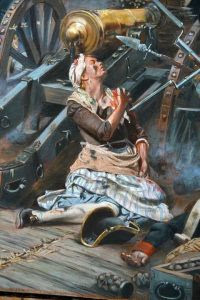 Corbin suffered horrific wounds in
Corbin suffered horrific wounds in
the service of her country
Corps of Invalids
In time, Corbin’s condition was made known to the Pennsylvania Executive Council, which granted her a small sum of money and referred her to the Continental Congress. The Board of War, impressed by her reputation as “Captain Molly,” then voted her a soldier’s half-pay for life on July 29 1779. Afterward, Corbin was allowed to join the Corps of Invalids at West Point, New York. Congress created the corps to garrison posts, using soldiers no longer fit for full active service.
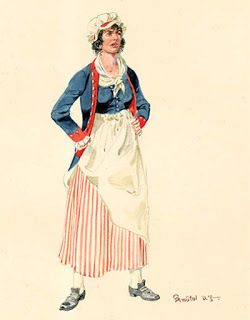 Corbin was assigned to the Corps of Invalids
Corbin was assigned to the Corps of Invalids
for the remainder of the war
Honorable Discharge & Second Marriage
She was also allotted one free suit of clothing per year or the equivalent in money. In 1782, Congress allowed her to receive a daily ration of rum due veteran soldiers. As the war drew to a close, she was formally discharged from the military in April 1783. While serving at West Point Margret married again. Her new husband was also an invalid, and the couple lived several years in grinding poverty. When he died, "Captain Molly" lived hand and mouth, often relying on the charity of locals.
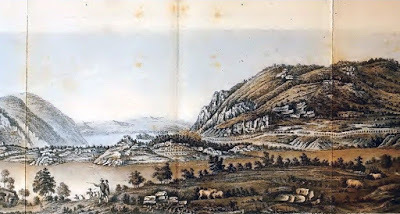 The Corps of Invalids garrisoned West Point
The Corps of Invalids garrisoned West Point
Legacy
Our female first patriot died just shy of her 50th birthday at Highland Falls, New York on January 16, 1800 and was buried in an unmarked grave.
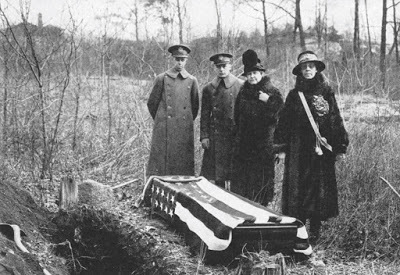 The DAR helped move Margaret Corbin's remains to its
The DAR helped move Margaret Corbin's remains to its
final resting place
There she lay until in the early 20th century, Corbin’s remains were subsequently rediscovered and, through the intervention of the daughters of the American revolution (DAR), she was interred at the US Military Academy in 1926 with full military honors. Her grave remains marked by a bronze memorial. Corbin was the first woman of the Revolutionary War to receive disability pension for military service. Ir is fitting that she was finally laid to rest with some of the great military heroes of America's wars.
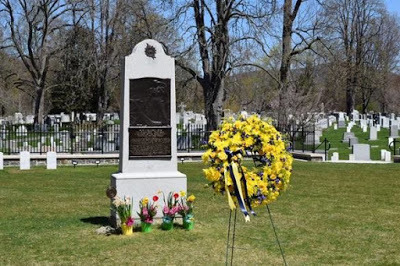 Margaret Corbin finally laid to rest at West Point's cemetery
Margaret Corbin finally laid to rest at West Point's cemetery
A plaque was erected on the site of Fort Washington in upper Manhattan, in today's Fort Tryon Park.
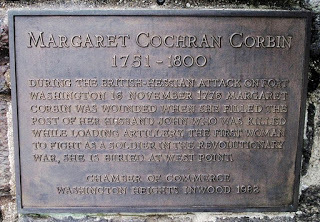
In an interesting side-note: Mary Corbin’s association with the artillery often causes her to be confused with another gunner, Mary Ludwig Hays, or Molly Pitcher, a common name for camp followers at the time. The other Molly may be the subject of a future Yankee Doodle Spies profile.
The American War for Independence would not have succeeded without the dedicated efforts of many women, from all walks of life. Besides the obvious morale support women provided the cause, they maintained the farms or ran the shops when the men-folk were with the army or the militia. They raised money and engaged in the day to day commerce that kept the economy going and helped feed the revolution. They organized efforts to sew and knit, providing badly needed garments, blankets and the like for an army poorly served by traditional logistics. Many also followed the gun, joining husbands or sweethearts with the forces as camp-followers. This female first patriot’s service began that way. But it did not end that way. Her name was Mary Chocrane Corbin, and she was indeed, a female bad-ass.
 Captain Molly - an original bad-ass
Captain Molly - an original bad-assFrontier Orphan
Margaret Chochrane (later changed to Chocran) was born near today’s Chambersburg, Pennsylvania in Franklin County, Pennsylvania, on 12 November, 1751, of Scotch-Irish settlers. Pennsylvania was a battlefront during the French and Indian War, however, and in 1756 and Indian attack changed her life for the worse. In a savage raid so common then, her father was killed and her mother carried off never to be seen again. Margaret escaped but now an orphan, she was raised by an uncle. This was not uncommon in those days. One can only think her hard scrabble youth steeled her for the challenges that lay in store for her.
 Margaret's mother was carried off in an Indian raid
Margaret's mother was carried off in an Indian raidNewlywed... New Recruit
In 1772, at the relatively old age of twenty-one, she married John Corbin, a Virginian who came to Pennsylvania during the war and lingered on. In the run up to the War for Independence John Corbin enlisted in Captain Thomas Proctor’s company of the 1st Continental Artillery. Corbin was a matross, a gunner’s assistant in an artillery crew. As a matross, it was John Corbin’s duty to assist the gunner in loading, firing and sponging the guns.
 John Corbin served as a matross, assistant gunner
John Corbin served as a matross, assistant gunnerFollow the Army
Like many women of her day, Margaret joined the army with her husband and served his unit as a camp follower. Camp followers were an essential component of 18th century armies, providing essential services such as cooking, washing clothes and blankets, fetching firewood and water. In combat, they often attended the wounded or carried water for the troops. Without the service of these dedicated women, soldiers of the Revolutionary War would have suffered even more than they did. Especially the Americans, whose logistics often lacked.
 Camp Followers were critical to the armies
Camp Followers were critical to the armiesActive Service
Margaret was with the Continental Army in this capacity at New York in 1776. By November of that year General Washington’s army had been driven from Brooklyn, had abandoned most of Manhattan, and had withdrawn to the Jerseys in the face of overwhelming British land and naval power. On Manhattan, the Continental Army was clinging to a small piece of rock at the northern tip of the island. Fort Washington stood high above the North (Hudson) River and the Harlem River, making it a critical piece of land. On November 16, General William Howe ordered a three-pronged bombardment and assault on Washington’s namesake bastion.
 Fort Washington
Fort WashingtonCaptain Molly
The fort’s defenders put up a desperate fight at first, stymieing the efforts of British and Hessian regulars. But soon the endless pounding of guns and determined assaults took its toll on the outnumbered defenders. John was assisting a gunner until the gunner was killed. At this point he took charge of the gun and Margaret stepped in to assist him. Before long, the intense British fire took him down - John Corbin was killed in combat. Undeterred, his wife now stepped in for him.
Margaret was often reported to have a feisty nature. On this day it would serve the forlorn cause at the fort. With no time to grieve her fallen husband, Margaret sprang into action and began serving one of the guns in his place, personally loading and firing round after round at the attackers. But the British soon trained their guns on the belching American cannon. Before long, Margaret herself was struck by a blast of grapeshot from the HMS Pearl firing from the river below the fort. A swarm of lead balls tore her into shoulder, mangled her chest and lacerated her jaw. Several soldiers carried her to the rear where she received what little treatment they could give.
 Captain Molly working a cannon at Fort Washington
Captain Molly working a cannon at Fort WashingtonWounded in the Line of Duty
The fort soon surrendered, and thousands of soldiers were marched off to eventual death on prison hulks. But Margaret’s wounds were so severe she was paroled by the fort’s new commandant, Hessian General von Knyphausen. Margaret and the other wounded were ferried across the river to Fort Lee. Bleeding from multiple wounds, and an arm hanging by a thread, Margaret suffered a wagon jolting and bumping along poor roads all the way to Philadelphia. She survived the journey and the wounds, although they would plague her the rest of her life. In addition, she permanently lost the use of her left arm.
 Corbin suffered horrific wounds in
Corbin suffered horrific wounds inthe service of her country
Corps of Invalids
In time, Corbin’s condition was made known to the Pennsylvania Executive Council, which granted her a small sum of money and referred her to the Continental Congress. The Board of War, impressed by her reputation as “Captain Molly,” then voted her a soldier’s half-pay for life on July 29 1779. Afterward, Corbin was allowed to join the Corps of Invalids at West Point, New York. Congress created the corps to garrison posts, using soldiers no longer fit for full active service.
 Corbin was assigned to the Corps of Invalids
Corbin was assigned to the Corps of Invalidsfor the remainder of the war
Honorable Discharge & Second Marriage
She was also allotted one free suit of clothing per year or the equivalent in money. In 1782, Congress allowed her to receive a daily ration of rum due veteran soldiers. As the war drew to a close, she was formally discharged from the military in April 1783. While serving at West Point Margret married again. Her new husband was also an invalid, and the couple lived several years in grinding poverty. When he died, "Captain Molly" lived hand and mouth, often relying on the charity of locals.
 The Corps of Invalids garrisoned West Point
The Corps of Invalids garrisoned West PointLegacy
Our female first patriot died just shy of her 50th birthday at Highland Falls, New York on January 16, 1800 and was buried in an unmarked grave.
 The DAR helped move Margaret Corbin's remains to its
The DAR helped move Margaret Corbin's remains to itsfinal resting place
There she lay until in the early 20th century, Corbin’s remains were subsequently rediscovered and, through the intervention of the daughters of the American revolution (DAR), she was interred at the US Military Academy in 1926 with full military honors. Her grave remains marked by a bronze memorial. Corbin was the first woman of the Revolutionary War to receive disability pension for military service. Ir is fitting that she was finally laid to rest with some of the great military heroes of America's wars.
 Margaret Corbin finally laid to rest at West Point's cemetery
Margaret Corbin finally laid to rest at West Point's cemeteryA plaque was erected on the site of Fort Washington in upper Manhattan, in today's Fort Tryon Park.

In an interesting side-note: Mary Corbin’s association with the artillery often causes her to be confused with another gunner, Mary Ludwig Hays, or Molly Pitcher, a common name for camp followers at the time. The other Molly may be the subject of a future Yankee Doodle Spies profile.
Published on February 29, 2020 11:21
January 28, 2020
The Surgeon General from Scotland
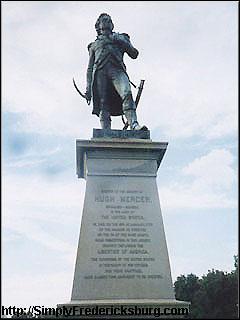
Fans of Outlander will immediately see the strange connection this first-patriot has with the main protagonists of the popular books and TV series,. A brawny, hot-headed Scot with a fiery passion meets cool, calculating medical professional who take on the British on two continents. Yet in this case they combined in one person - Hugh Mercer, a man who cut a swathe from the streets of Aberdeen, to the rugged bloody field of Culloden, to the war torn mountains of Pennsylvania and the frozen farmlands of the Jerseys.
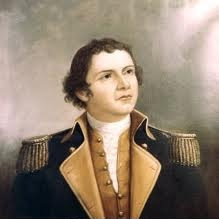 General Hugh Mercer
General Hugh MercerThe Streets of Aberdeen
Hugh Mercer was born in Aberdeenshire, Scotland, in 1725 to the Reverend William Mercer, a Church of Scotland minister and Ann Monro. He passed through the University of Aberdeen with a medical degree in 1744. That year, he joined the Jacobite army of Prince Charles Edward, the Pretender, and served as assistant surgeon at the disastrous engagement of Culloden in April 1746. He escaped the butchery that followed the battle and after months on the run, fled to America.
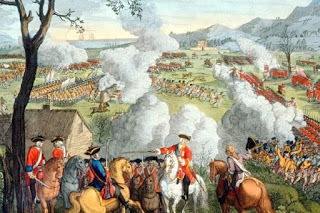
Country Doctor
The young surgeon, war-veteran and fugitive settled in present-day Mercerville, Pennsylvania, to ply his profession as a physician. When the French and Indian War broke out in 1755, he set aside his eight years of comfortable medical practice and offered his services to the provincial forces, taking part in several notable actions.
Another Massacre
On the western frontier of Pennsylvania, Mercer helped treat the survivors of General Braddock’s destruction on the Monongahela River. Appalled by the butchery suffered by the wounded, Mercer put aside his disdain for the crown and joined the Britain’s struggle for America.
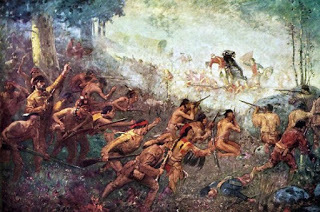
Punitive Expedition
In September 1756, the newly appointed captain accompanied Colonel John Armstrong on his punitive expedition against the Indian villages at Kittanning and was severely wounded. Cut-off, he survived on his own for two weeks wandering over 100 miles before reaching the friendly outpost at Fort Shirley. His devotion and gallantry were recognized.
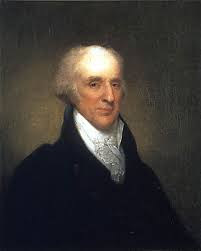 Mercer served under Col John Armstrong
Mercer served under Col John Armstrongin western Pennsylvania raid
Fort Duquesne
Two years later he fought as a lieutenant colonel at the capture of Fort Duquesne (renamed Fort Pitt, now Pittsburgh) and subsequently commanded there. Mercer's first task was to construct a temporary fort to hold the two forks of the Ohio in case the French returned from the northwest. During this campaign Mercer met and befriended Colonel George Washington of the Virginia regiment. It would be an enduring friendship.
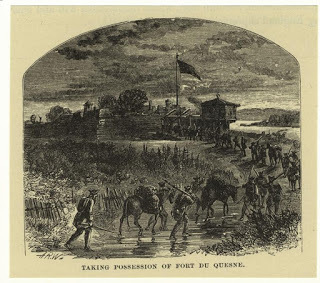
The Old Dominion
The war ended in 1763 and because he had made friends with several Virginians, he decided to settle in a small port town with a small community of Scot expats. Though Mercer arrived in Fredericksburg to establish a medical practice, he found much more. The town filled a void present since fleeing his homeland.
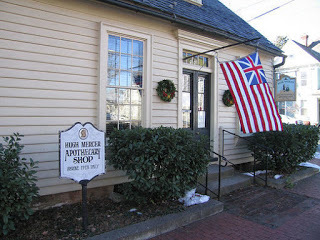 Mercer opened an Apothecary in his
Mercer opened an Apothecary in hisadopted town of Fredericksburg
First Mother's Physician
In addition to practicing medicine, Mercer opened an apothecary in town. Like so many settlers, he bought land. He was physician to George Washington’s mother, Mary Ball Washington and bought the Ferry Farm from her as his family homestead.
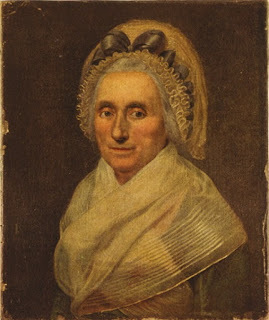 One of Mercer's celebrated patients
One of Mercer's celebrated patientswas Mary Ball Washington
Civic Leader
He became active in local issues in town and was a prominent businessman. Along the way he joined the masonic lodge that included Washington and so many other prominent Virginians. To say he was at last comfortable with life is an understatement. But he would soon leave his comfort to follow the drum one last time.
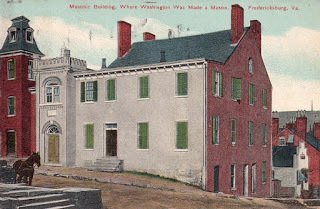 Mercer, George Washington and numerous founders
Mercer, George Washington and numerous foundersbelonged to the Fredericksburg Masonic Lodge
The Minuteman
By 1775 the tensions between Britain and its colonies in North America had morphed from resistance to insurgency and then war. It was only natural the bold freedom-lover Mercer was would throw in his lot with the glorious cause and face his former enemies once more. He became a member of the Fredericksburg Committee of Safety. In September, Mercer was named commander of all minuteman companies in the four counties around Fredericksburg.
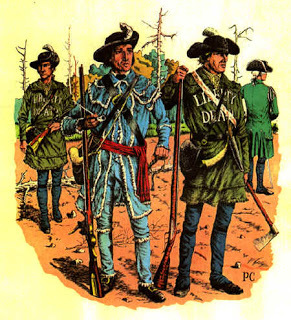 Virginia Minutemen
Virginia MinutemenThe Continental
In January 1776 his talents were once more recognized. Virginia’s provincial congress appointed him colonel in the 3rd Virginia Continental Line. He set to work drilling it into a crack unit but that command was short-lived. His old friend and comrade in arms, George Washington, was now commander in chief of the new Continental Army. Mercer enjoyed a fine military reputation, so Washington petitioned the Continental Congress to appoint him brigadier general that June.
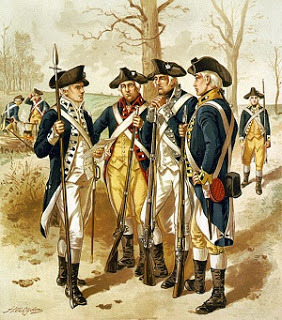 Mercer commanded a Continental Line regiment
Mercer commanded a Continental Line regimentbut was quickly promoted to the rank of
Brigadier General
Flying Camp Days
Washington immediately entrusted him to command the so-called Flying Camp, a mobile military reserve. He tried to employ it to support the main army during the New York campaign, but the unit was plagued by desertions, lack of manpower, and supply shortages. The Flying Camp was disbanded that winter.
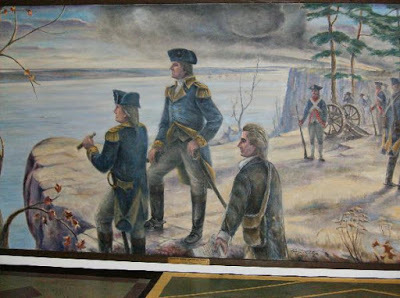 Fort Lee before evacuation
Fort Lee before evacuationBattle Across the Jerseys
Mercer was also given the task of building what became Fort Lee on the New Jersey side of the North (Hudson) River. Although the fort fell without a fight during the British invasion of the Jerseys in late 1776, Mercer still enjoyed Washington’s complete confidence. He played a prominent role during the daring and masterful counter-stroke at Trenton on 26 December 1776, His brigade played a prominent role in driving the Hessian garrison out of the town where they were forced to surrender in a nearby field.
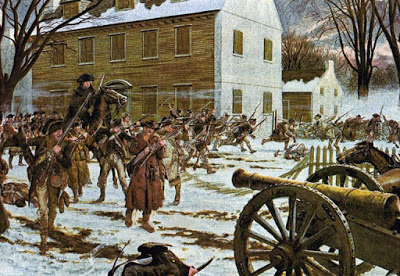 Mercer commanded a brigade at the crucial
Mercer commanded a brigade at the crucialassault on the Hessian garrison at Trenton
Escape from Assunpink
The Americans eventually moved to Assunpink Creek to await the inevitable British counter-stroke by a column of some 5,000 led by Major General Charles Earl Cornwallis. Some say Mercer may have suggested the famous rouse of leaving fires burning. Regardless, the British were duped when the Americans slipped away into the night and got behind Cornwallis’s column and attacked Princeton.
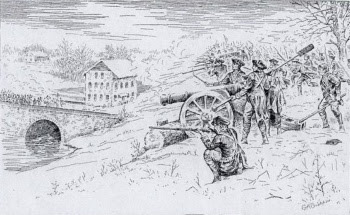 After repulsing Cornwallis's columns at Assunpink Creek
After repulsing Cornwallis's columns at Assunpink Creekthe Americans slipped away in the night
Advance on Princeton
On 3 January 1777, Mercer, leading the advance corps ahead of the main body, ran into a brigade of some 1200 British regulars under Lieutenant Colonel Charles Mawhood of the 17th regiment of Foot. A bloody exchange of volleys erupted in the vicinity of Stony Brook Bridge. Rather than retreat under the press of the redcoats, the imposing Scot plunged into battle against the better trained British. But his troops were forced back after stiff fighting.
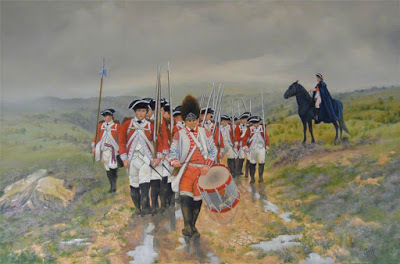 Mawhood's brigade was all that stood
Mawhood's brigade was all that stoodbetween Mercer and Princeton
Clash and Flurry of Blades
While attempting to rally his men, Mercer was shot off his horse. Refusing to surrender he drew his saber but was overpowered and bayoneted several times by angry British soldiers (who may have thought he was Washington). Fatally wounded, he was then carried to the nearby home of Thomas Clarke, where a British surgeons mate and some local women cared for him. When Washington learned his fate, he reached out to Cornwallis who graciously allowed Washington’s leading physician, Dr. Benjamin Rush, to attend the dying general.
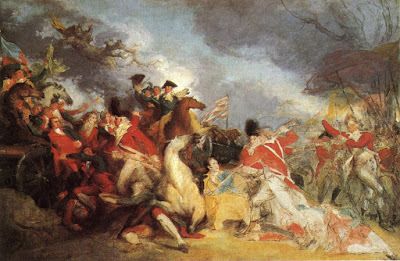 British bayonets mortally wound the gallant Scot turned Yankee
British bayonets mortally wound the gallant Scot turned YankeeFinal Home
The gallant soldier-surgeon Mercer lingered on but finally succumbed to his wounds on 12 January 1776. His body was taken to Philadelphia where he was buried. Had Mercer survived he clearly would have played an even more prominent role in securing America's freedom. But the greater tragedy is this educated and dedicated soldier-surgeon never had the chance to help build the nation whose liberty was paid for by his blood.
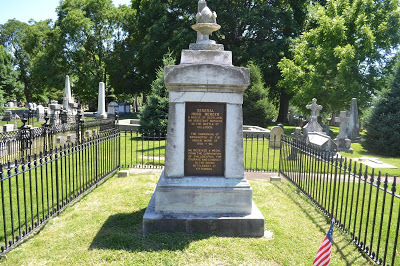 Gen Hugh Mercer's grave
Gen Hugh Mercer's grave
Published on January 28, 2020 16:39
December 28, 2019
The Kentuckian
It is time we turn our attention to the south once more. The region is replete with first patriots whose names were legend to the generations following the struggle for independence but are lost in the mists of time. The southern struggle was most remembered by the exploits of Marion and Sumter. But countless others played roles large and small. Not the least of these were those bad asses called the “Over Mountain Men.” Hard-nosed and hard-fisted settlers west of the Appalachian Mountains steeped in hunting, fighting and hard liquor. This edition profiles one of these: Isaac Shelby.
Family of Migrants
Isaac Shelby was born in Hagerstown, Maryland on 11 December 1750. His father, Evan Shelby, hailed from Tregaron, Cardiganshire, Wales, and had come to America in 1734. About 1773, Evan moved his family to the Holston region of what is now upper East Tennessee but was then part Virginia.
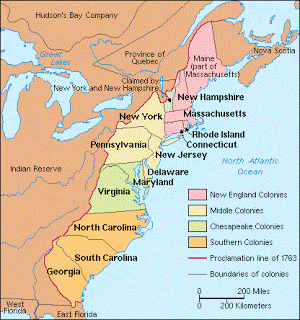 In mid 18th century the Alleghenies
In mid 18th century the Alleghenieswere the western frontier
Raised on the Range
Young Isaac grew up steeped in the frontier world of rough and tumble living and fighting. He early learned the use of arms and became accustomed to the rigors of western life. He received a fair education, worked on his father's plantation, occasionally surveyed land, and at age eighteen became a deputy sheriff.
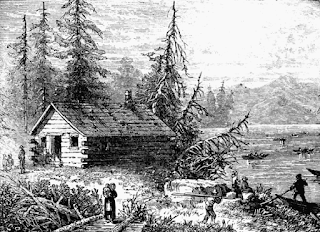 Frontier cabin
Frontier cabinBig Strong Man
Isaac Shelby was a large man, six feet tall, powerful, and well proportioned, with a striking countenance and ruddy complexion. He could endure long hours of work, physical hardship, and great fatigue. Dignified and impressive in bearing, he was nevertheless affable and winning. In short, a natural leader. He was also smart and had obvious executive skills that served him well in peace and war.
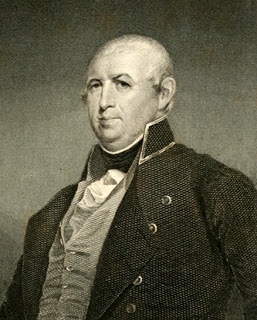 Shelby in later life
Shelby in later lifeLord Dunmore's War
When the Earl of Dunmore, Virginia Royal Governor John Murray. went to war with the Shawnee under Chief Cornstalk, Shelby joined the nearby militia as a lieutenant, serving under his father. On 10 October 1774 young Shelby fought in the Battle of Point Pleasant. He achieved early military success in the battle by charging the high ground on the Indian flank, forcing them to abandon the field. This was just a prelude to things to come.
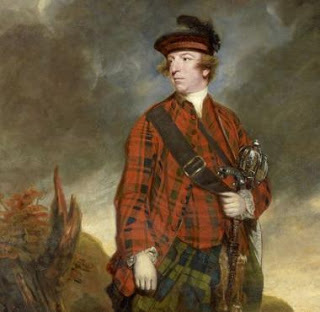 John Murray,Royal Governor of
John Murray,Royal Governor ofVirginia
A Rebel Goes West
The American Revolution went hot in 1775 and by 1776 Shelby had rejoined the militia, this time as a captain. Virginia’s Governor, Patrick Henry, appointed him to a post on Virginia’s western frontier. There he provided direct support to Colonel George Rogers Clark’s thrust into the Illinois Territory. Isaac also played a role in well his father’s victory over the Indian chief Dragging Canoe in a battle on the Tennessee River in 1779.
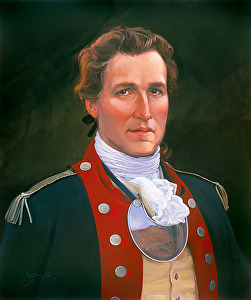 Shelby provided logistic support to
Shelby provided logistic support toGeorge Rogers Clark's western campaign
Me? A Tar Heel?
Eighteenth century boundaries in this region were advisory at best. When he discovered that his homestead was actually in North Carolina, Isaac became a colonel of militia there. He also won a seat in the state assembly. Although a newly minted Tar Heel, Shelby was in Kentucky when Charleston fell to the British in 1780 and the triumphant and exuberant redcoats began to overrun his state. At word of the new threat he hurried home and raised some 200 men for the cause. He immediately joined forces with Colonel Joseph McDowell to try to block the advance of British General Charles Cornwallis and his Loyalist supporters.
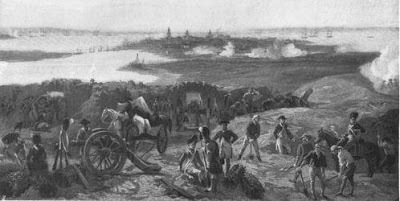 The Fall of Charleston opened up the Carolinas
The Fall of Charleston opened up the Carolinasto the Southern Strategy
Guerrilla Days
His first major test came on 31 July when Shelby and his men managed to surround Thickety Fort on the Pacolet River. His swagger and deception enabled him to bluff the commander to surrender his 94 men. Shelby then joined forces with a band of partisans under Lieutenant Colonel Elijah Clarke. With a combined force of 200 men they attacked a Loyalist outpost at Musgrove Mills. Although outnumbered almost two to one they drove off the Loyalists in a fierce skirmish.
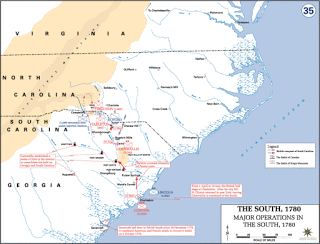
Enter the Counter Guerrilla
These activities posed a threat to Cornwallis’s security, so the British general dispatched perhaps the army’s best guerrilla fighter, Major Patrick Ferguson. But when the patriot army under General Horatio Gates was annihilated at Camden on 16 August 1780, pretty much all resistance collapsed throughout the south. It looked like the British “southern strategy “was going to pay off.
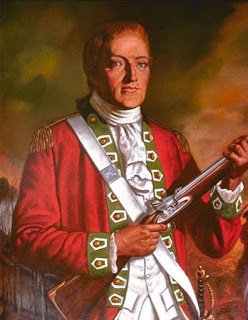 Major Patrick Ferguson
Major Patrick FergusonRun Away
For his part, Shelby withdrew to the west with McDowell and their forces dissolved into the frontier hinterland. There they would wait out events. But local atrocities by Loyalist bands angered the southerners and in a series of partisan and guerrilla actions, they continued resistance.
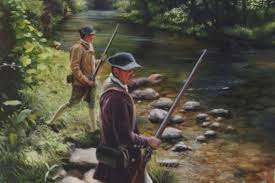 Partisan militia
Partisan militiaThe Lord's Prayer
Seeking to consolidate the Carolinas under British authority, Lord Cornwallis marched an army into North Carolina in a gambit that would ultimately backfire. With him went Ferguson who issued a bold challenge to the “Over Mountain Men” as the frontier rebels were called. The threat was blunt: submit to the crown, or their homes would be put to the torch. But the men of the west were unimpressed. In fact, this galvanized the frontiersmen.
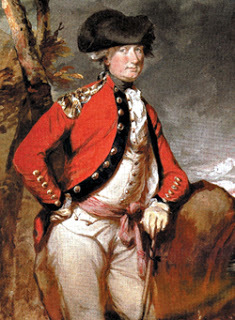 Major General Charles Cornwallis
Major General Charles CornwallisBand of Bothers, Tough Mothers
Shelby, along with another over mountain man from Tennessee, John Sevier, raised a force of 200 volunteers, rallied at Sycamore Shoals and soon plunged into war torn North Carolina. There they joined forces with Colonel William Campbell. Anxious for revenge, the over mountain men moved hell bent for leather to get Ferguson. The feeling was mutual. The famed counter - guerrilla led a force of some 900 Loyalists itching to subdue the rebels.
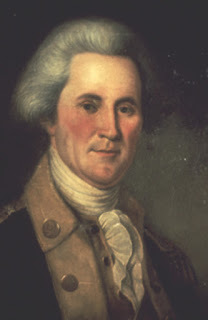 John Sevier - another
John Sevier - another Over Mountain Bad Ass
Go Tell it to the Mountain
But the ride was turned on Ferguson, who was surrounded on a stretch of high ground called King’s Mountain (just over the border in South Carolina) and cut off from the main British column under Cornwallis. Withering and accurate fire from the rifles of the westerners devastated the Loyalists. Ferguson was shot trying to rally a defense and soon died. The few who did not taste lead eventually surrendered. Shelby played a conspicuous role in planning and executing the operation and soon became a local hero.
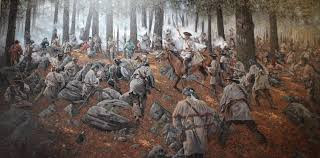 Kings Mountain was a turning point i n the South
Kings Mountain was a turning point i n the SouthDraining the Swamp, with the Swamp Fox
After King’s Mountain, Cornwallis’s strategy began to unravel. But there was more fighting to be done. Shelby joined forces with famed partisan general Francis Marion and assisted in seizing Monk’s Corner. Fighting continued throughout the south even after the surrender of Cornwallis at Yorktown in October 1781. But the British and their Loyal allies were beaten.
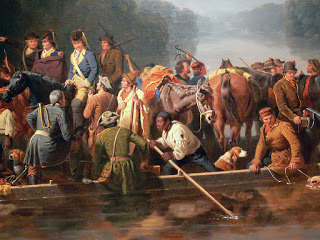 Francis Marion and his partisan militia
Francis Marion and his partisan militia
The Kentuckian
After the war, Shelby retired to private life, where his wartime heroics resulted in a successful political career. He moved to Kentucky and helped organize the territory, develop infrastructure, improve defenses against the Indians and their British allies. On 19 April 1783, at Boonesboro, he married Susannah Hart, daughter of Captain Nathaniel Hart, one of the earliest settlers of Kentucky. Susannah eventually bore him eleven children.
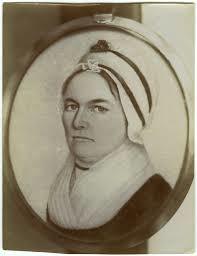 Susannah Hart Shelby
Susannah Hart ShelbyPolitician, Pundit and Warrior
In 1792 he was elected governor of the recently admitted state. He was a critic of President Washington’s foreign policy. Many westerners wanted a more aggressive stance against the British forts to the west and the Indians. However, he provided unstinting support to Major General Anthony Wayne’s Legion during the Indian campaigns of 1794. In 1812 Shelby was once again elected governor. His military and organizational skills went to work mobilizing Kentucky’s militia for war. In 1813 he personally led a force of 3,500 mounted riflemen north to support General William Henry Harrison’s army near Thames, Ontario. After the war, Congress struck a gold medal in his honor.
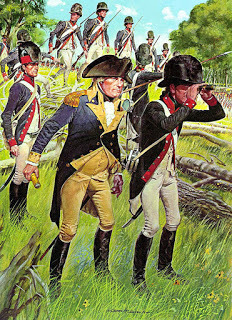
Gen Anthony Wayne's American Legion
Diplomat to the Indians
In 1817, he declined President James Madison’s offer to serve as Secretary of War. His last significant contribution to the over mountain region came in 1818 when he, Andrew Jackson, and others negotiated the “Jackson Purchase,” which removed control of the western districts of Kentucky and Tennessee from the Chickasaw Indians. This opened the western region to settlement. To honor this service, the Tennessee General Assembly named Shelby County (Memphis) for him.
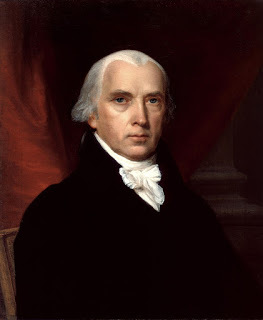 President James Madison
President James MadisonA Model for the West
The fighting governor died near Danville, Kentucky in July 1826. He was mourned as a celebrated public servant and soldier. One of the nation’s most remarkable frontiersmen, Shelby provided the model for those later frontiersmen who would forge the Republic of Texas and help solidify America’s western expansion.
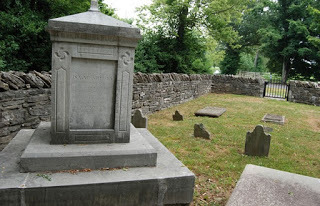 Shelby Cemetery is a KY historic site
Shelby Cemetery is a KY historic site
Published on December 28, 2019 09:45
November 3, 2019
The Mechanics
Genesis of Clandestine Warfare
The American War for Independence was the culmination of over a decade of political unrest and discontent with British policies and treatment (real and perceived) of the colonists. Although led by some of the brightest minds of the age, or any age, the movement was also a grass roots movement, which gradually built to a political movement – the idea of the ideas bantered around in taverns, coffee houses, homes and farmsteads.

By the early 1770s the movement spurred what was to become an insurgency of sorts. Insurgencies are of their own nature clandestine and they necessitate the development of clandestine activities and the trade-craft (use of spies, secret writing, etc.) necessary for success. As the political side of the patriot movement grew, organizations like “The Sons of Liberty” also sprung up, serving as the action arm.
Boston Ablaze
By the outbreak of rebellion in 1775, the Americans had established organizations necessary to wage the clandestine side of the war as these were already well underway. The British had their counter to this but these activities tended to lag and over time became eclipsed by the Americans’ ability to control the ground in all but those few areas dominated by the British Army and Royal Navy.
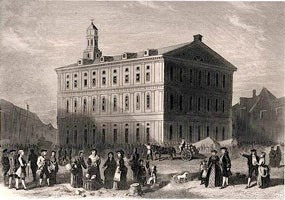 Boston's Fanueil Hall was the site of much
Boston's Fanueil Hall was the site of much
political agitation & intrigue
One of the first clandestine networks established was, of course, in Boston. This was only natural as Boston was the scene of so much political and subversive discourse during the pre- Rev War period. Names like Sam Adams, Paul Revere and John Hancock were legend even then. “Agitprop” became a really effective tool as crowds were whipped up for all sorts of things. In a way, the British missteps in countering all this activity in Boston fueled the flames that eventually burst into a conflagration that scorched the eastern seaboard after April 1775.
Enter the Mechanics
The first patriot intelligence network was a secret group in Boston called the Mechanics. The Mechanics were spawned in Boston from “The Son’s of Liberty" , known famously for their opposition to the Stamp Act and other repressive measures. But the mechanics operated a bit differently. They organized clandestine activities in resistance to British authority. They also gathered intelligence, the lifeblood of the resistance. It began as a group of some thirty “mechanics,” men who worked in hands on trades in and about the city.
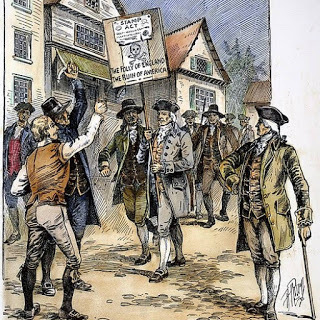 Observing counter demonstrators helped
Observing counter demonstrators helped
build situational awareness of British sympathizers
Paul Revere was among the first. By his own words they, “…formed ourselves into a Committee for the purpose of watching British soldiers and gaining every intelligence on the movements of the Tories.”
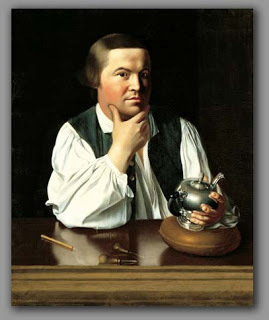 Paul Revere was one of the craftsmen-spies
Paul Revere was one of the craftsmen-spies
who became know as the Mechanics
The key component is the latter. They realized the key to success was neutralizing British sympathizers early on. Revere further stated, “We frequently took turns, two and two, to watch the soldiers by patrolling the streets at night.” Operating under cover of darkness would be a key component of future clandestine activities right up to today. In addition to observing British soldiers and Tories, Revere and the mechanics served as couriers, the essential oil of any clandestine network. Communications is the Achilles heal of clandestine work so the couriers held a special role. The Mechanics played a key role in countering the efforts to suppress the colonial insurgency.
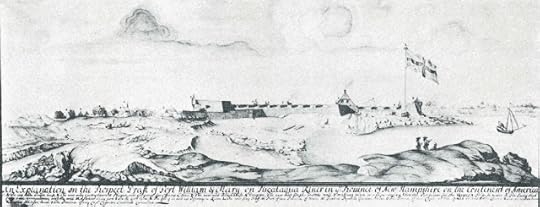 Mechanic Paul Revere alerted General Sullivan of the British intention to seize
Mechanic Paul Revere alerted General Sullivan of the British intention to seize
Fort William and Mary
One of Revere’s first missions as a courier took place in December 1774. He rode to the Oyster River in New Hampshire with a report that General Thomas Gage the British commander and governor, planned to take Fort William and Mary. Alerted by the intelligence delivered by the Mechanics, Major John Sullivan led a colonial militia force of four hundred men in a preemptive raid on the fort. They seized one hundred barrels of gunpowder that were ultimately used by the patriots at Bunker Hill
Clandestine Communications
Things really heated up around Boston in early 1775. Both sides became more aggressive and the stakes grew with each month. Through a number of intelligence sources the Mechanics broke the cover established by General Gage for their quick strike on Lexington and Concord. The British counted on secrecy for success. Thanks to the intelligence and warning by the Mechanics, they failed.
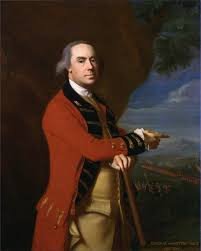 The Mechanics' espionage activities
The Mechanics' espionage activities
were a bane to British General Thomas Gage
Revere received orders from Dr. Joseph Warren, then head of the local Committee of Safety, directing him with warning the key patriot leaders in the region, John Hancock and Samuel Adams, of the British plan to take them in a secret raid on Lexington. Revere arranged for the signal lanterns at the Old North Church. Working with William Dawes, the two rebel leaders were warned. Riders were sent out to alert the militia and then Revere, Dawes and a Dr. Samuel Prescott went on to warn the militias at Concord of the second phase of the operation – seizing the weapons there.
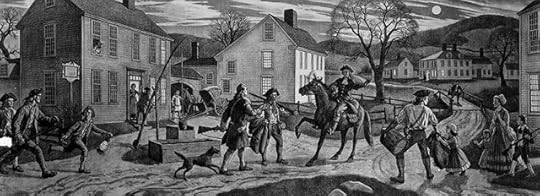 In addition to Revere, Dawes and Prescott, other secret riders
In addition to Revere, Dawes and Prescott, other secret riders
warned the villages of the approaching British
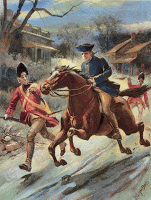 British capture Revere
British capture Revere
A British patrol at Lincoln almost ended things before they started. During the chase, Dawes was thrown from his horse while fleeing. But Prescott and Revere were taken prisoner. Prescott soon escaped British capture and made his way to Concord, but Revere remained a prisoner. However, the doughty silversmith, resisted interrogation and was soon released and made his way to Lexington where he and John Lowell were dispatched to retrieve a trunk full of incriminating patriot papers at a local tavern.
A Dearth of Knowledge
In a sense, the dearth of recorded knowledge on the Mechanics is a good thing, not for historians but for the nation. Any records kept, were probably very local and perishable. That is, destroyed on completion of the operation. Operations security came naturally to those seeking survival in a clandestine war. But mistakes are made and can be costly. The trunk Revere was sent to retrieve could have provided the British a trove of intelligence that might have snuffed out the flame of rebellion in New England, and thus ended things.
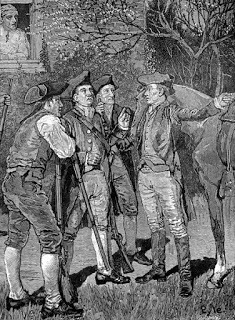 Mechanic reporting intelligence
Mechanic reporting intelligence
on British activities
A curious example of bureaucratic snafu accidentally preventing failure also involves our celebrated Mechanic, Revere. The mechanics evidently received written orders and some sort of remuneration for their expenses. The orders may have been used to get through militia patrols. For whatever reason, Revere only received his orders from Dr. Warren,leader of the local Committee of Correspondence, two weeks after his clandestine ride. Had he had them with him, his role would have been exposed to the British when they searched him. History again might have taken a distinctly different course.
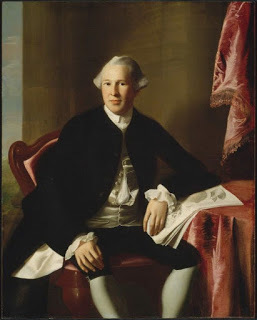 As leader of the Boston Committee of Correspondence
As leader of the Boston Committee of Correspondence
Dr. Joseph Warren leveraged the mechanics to
collect and report intelligence on the British
And for those readers who have served in government bureaucracies or the military, his remuneration was cut from five schillings per day to four.
The American War for Independence was the culmination of over a decade of political unrest and discontent with British policies and treatment (real and perceived) of the colonists. Although led by some of the brightest minds of the age, or any age, the movement was also a grass roots movement, which gradually built to a political movement – the idea of the ideas bantered around in taverns, coffee houses, homes and farmsteads.

By the early 1770s the movement spurred what was to become an insurgency of sorts. Insurgencies are of their own nature clandestine and they necessitate the development of clandestine activities and the trade-craft (use of spies, secret writing, etc.) necessary for success. As the political side of the patriot movement grew, organizations like “The Sons of Liberty” also sprung up, serving as the action arm.
Boston Ablaze
By the outbreak of rebellion in 1775, the Americans had established organizations necessary to wage the clandestine side of the war as these were already well underway. The British had their counter to this but these activities tended to lag and over time became eclipsed by the Americans’ ability to control the ground in all but those few areas dominated by the British Army and Royal Navy.
 Boston's Fanueil Hall was the site of much
Boston's Fanueil Hall was the site of muchpolitical agitation & intrigue
One of the first clandestine networks established was, of course, in Boston. This was only natural as Boston was the scene of so much political and subversive discourse during the pre- Rev War period. Names like Sam Adams, Paul Revere and John Hancock were legend even then. “Agitprop” became a really effective tool as crowds were whipped up for all sorts of things. In a way, the British missteps in countering all this activity in Boston fueled the flames that eventually burst into a conflagration that scorched the eastern seaboard after April 1775.
Enter the Mechanics
The first patriot intelligence network was a secret group in Boston called the Mechanics. The Mechanics were spawned in Boston from “The Son’s of Liberty" , known famously for their opposition to the Stamp Act and other repressive measures. But the mechanics operated a bit differently. They organized clandestine activities in resistance to British authority. They also gathered intelligence, the lifeblood of the resistance. It began as a group of some thirty “mechanics,” men who worked in hands on trades in and about the city.
 Observing counter demonstrators helped
Observing counter demonstrators helpedbuild situational awareness of British sympathizers
Paul Revere was among the first. By his own words they, “…formed ourselves into a Committee for the purpose of watching British soldiers and gaining every intelligence on the movements of the Tories.”
 Paul Revere was one of the craftsmen-spies
Paul Revere was one of the craftsmen-spieswho became know as the Mechanics
The key component is the latter. They realized the key to success was neutralizing British sympathizers early on. Revere further stated, “We frequently took turns, two and two, to watch the soldiers by patrolling the streets at night.” Operating under cover of darkness would be a key component of future clandestine activities right up to today. In addition to observing British soldiers and Tories, Revere and the mechanics served as couriers, the essential oil of any clandestine network. Communications is the Achilles heal of clandestine work so the couriers held a special role. The Mechanics played a key role in countering the efforts to suppress the colonial insurgency.
 Mechanic Paul Revere alerted General Sullivan of the British intention to seize
Mechanic Paul Revere alerted General Sullivan of the British intention to seizeFort William and Mary
One of Revere’s first missions as a courier took place in December 1774. He rode to the Oyster River in New Hampshire with a report that General Thomas Gage the British commander and governor, planned to take Fort William and Mary. Alerted by the intelligence delivered by the Mechanics, Major John Sullivan led a colonial militia force of four hundred men in a preemptive raid on the fort. They seized one hundred barrels of gunpowder that were ultimately used by the patriots at Bunker Hill
Clandestine Communications
Things really heated up around Boston in early 1775. Both sides became more aggressive and the stakes grew with each month. Through a number of intelligence sources the Mechanics broke the cover established by General Gage for their quick strike on Lexington and Concord. The British counted on secrecy for success. Thanks to the intelligence and warning by the Mechanics, they failed.
 The Mechanics' espionage activities
The Mechanics' espionage activitieswere a bane to British General Thomas Gage
Revere received orders from Dr. Joseph Warren, then head of the local Committee of Safety, directing him with warning the key patriot leaders in the region, John Hancock and Samuel Adams, of the British plan to take them in a secret raid on Lexington. Revere arranged for the signal lanterns at the Old North Church. Working with William Dawes, the two rebel leaders were warned. Riders were sent out to alert the militia and then Revere, Dawes and a Dr. Samuel Prescott went on to warn the militias at Concord of the second phase of the operation – seizing the weapons there.
 In addition to Revere, Dawes and Prescott, other secret riders
In addition to Revere, Dawes and Prescott, other secret riderswarned the villages of the approaching British
 British capture Revere
British capture Revere A British patrol at Lincoln almost ended things before they started. During the chase, Dawes was thrown from his horse while fleeing. But Prescott and Revere were taken prisoner. Prescott soon escaped British capture and made his way to Concord, but Revere remained a prisoner. However, the doughty silversmith, resisted interrogation and was soon released and made his way to Lexington where he and John Lowell were dispatched to retrieve a trunk full of incriminating patriot papers at a local tavern.
A Dearth of Knowledge
In a sense, the dearth of recorded knowledge on the Mechanics is a good thing, not for historians but for the nation. Any records kept, were probably very local and perishable. That is, destroyed on completion of the operation. Operations security came naturally to those seeking survival in a clandestine war. But mistakes are made and can be costly. The trunk Revere was sent to retrieve could have provided the British a trove of intelligence that might have snuffed out the flame of rebellion in New England, and thus ended things.
 Mechanic reporting intelligence
Mechanic reporting intelligenceon British activities
A curious example of bureaucratic snafu accidentally preventing failure also involves our celebrated Mechanic, Revere. The mechanics evidently received written orders and some sort of remuneration for their expenses. The orders may have been used to get through militia patrols. For whatever reason, Revere only received his orders from Dr. Warren,leader of the local Committee of Correspondence, two weeks after his clandestine ride. Had he had them with him, his role would have been exposed to the British when they searched him. History again might have taken a distinctly different course.
 As leader of the Boston Committee of Correspondence
As leader of the Boston Committee of CorrespondenceDr. Joseph Warren leveraged the mechanics to
collect and report intelligence on the British
And for those readers who have served in government bureaucracies or the military, his remuneration was cut from five schillings per day to four.
Published on November 03, 2019 09:05
September 28, 2019
Tinkerer, Sailor, Soldier, Surgeon
A Connecticut Yankee
So many of our first patriots were accomplished men of letters, lawyers, judges, planters, merchants but relatively few were men of science and technology. David Bushnell falls into the latter category.
Bushnell was born in Saybrook, Connecticut on 30 August 1742, the son of a farmer. He was the first of five children and grew up and worked the family farm near Westbrook. Following the death of his father in 1769, he sold his half interest in the farm to his brother Ezra and entered Yale College in 1771.
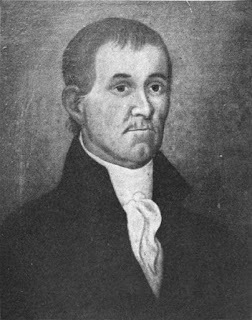 David Bushnell
David Bushnell
Bombs to Boats
While at Yale he became fascinated by the possibility of underwater explosions. An inventive tinkerer by nature, Bushnell successfully combined a black powder charge with a clockwork timing device, thereby creating the first naval mine. He used this knowledge not only in construction of the underwater mine but later in creating floating torpedoes that exploded on contact. He collaborated with the wealthy New Haven inventor and manufacturer Isaac Doolittle to develop the first mechanically triggered time bomb as well as the first screw propeller. As he set about conceiving a practical delivery system for this unique weapon, the onset of the American War for Independence created a new sense of urgency to his efforts. By the fall of that year he had designed and engineered the American Turtle (better known as Turtle), a primitive submarine. He named it Turtle because it looked like two turtle shells lashed together. Not a thing of beauty, but it worked.
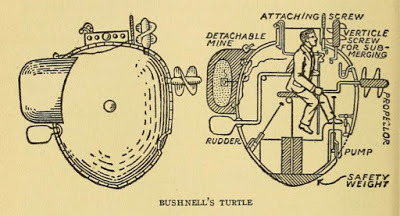 Turtle Design Sketch
Turtle Design Sketch
Test and Evaluation
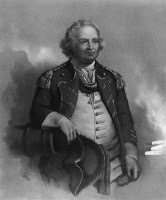 Gen Israel PutnamThis primitive submarine was manned by a single operator who powered it by two hand-cranked screw propellers. A system of water pumps took in and expelled water to control the climb or descent of the craft, which could reach a depth of about 15 feet. To see, the pilot had a small conning tower with several windows. The tower contained a depth gauge and a compass lit by phosphorous. The Turtle’s punch was Bushnell’s original clock/min e combination connected to a a metal drill engineered to bore through the copper sheathing coating the hulls of British warships. Once the mine was attached and released, the timing mechanism engaged leaving the Turtle one hour to escape before 150 pound charge exploded, detonated by a flintlock trigger device. Bushnell arranged a successful demonstration, essentially a “demval” in today’s acquisition parlance. On hand for the event on the Thames River was Connecticut General Israel Putnam, who urged the American government to continue funding for its “full operational capability.”
Gen Israel PutnamThis primitive submarine was manned by a single operator who powered it by two hand-cranked screw propellers. A system of water pumps took in and expelled water to control the climb or descent of the craft, which could reach a depth of about 15 feet. To see, the pilot had a small conning tower with several windows. The tower contained a depth gauge and a compass lit by phosphorous. The Turtle’s punch was Bushnell’s original clock/min e combination connected to a a metal drill engineered to bore through the copper sheathing coating the hulls of British warships. Once the mine was attached and released, the timing mechanism engaged leaving the Turtle one hour to escape before 150 pound charge exploded, detonated by a flintlock trigger device. Bushnell arranged a successful demonstration, essentially a “demval” in today’s acquisition parlance. On hand for the event on the Thames River was Connecticut General Israel Putnam, who urged the American government to continue funding for its “full operational capability.”
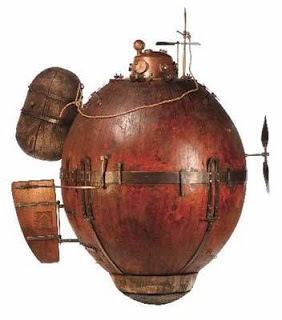 Turtle Replica
Turtle Replica
Run Silent, Run Deep - Sorta
History was made in the summer of 1776 when the Turtle made an attack on British fleet anchored in New York harbor under the command of Admiral Richard Howe. Unfortunately, Bushnell became ill and a Sergeant named Erza Lee volunteered in his place. On the night of 6 September a pair of whale boats towed the Turtle off shore where it began its attack. Pumping feverishly, Lee slowly guided the Turtle towards the British fleet. Despite unfair tides, Lee managed to pull up to the mother of all targets, Lord Howe’s own flagship, the 64-gun ship of the line, HMS Eagle. The Turtle’s drill failed to penetrate the hull because it was blocked by an iron bar. With air dwindling, Lee abandoned the efforts and released the mine, which floated free. The mine finally erupted with a tremendous explosion that shot a plume of water into the night air. The unexpected iron bar prevented what could have been a catastrophic kill on a major target, possibly changing British naval tactics for the duration of the war. See my Yankee Doodle Spies post on "The Boat" fore a more detailed discussion of this attack.
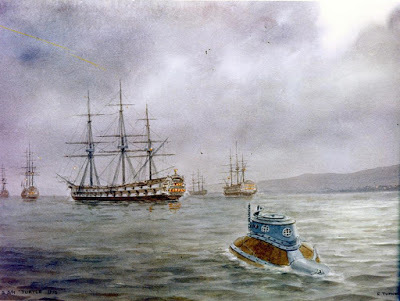 Bushnell's Turtle takes on HMS Eagle
Bushnell's Turtle takes on HMS Eagle
and initiates submarine warfare
Torpedoes are Running
Bushnell was undaunted. Confident in his development he continued improving the Turtle. He launched several small attacks against individual British ships but inexperienced pilots and unfavorable tides thwarted each effort. The Turtle was lost the following October when a transport carrying it was sunk by British cannon fire on the North (Hudson) River. Undaunted by all the failure, Bushnell continued tinkering with naval mines and explosives. On 13 August 1777, he released another mine that floated toward the HMS Cerebus, anchored in Black Point Bay. This time the tides were favorable but the device got snagged up with a small schooner. It detonated the explosion killing three British sailors.
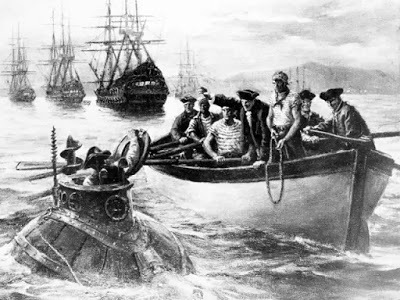 Turtle needed to be towed into attack position by rowboats
Turtle needed to be towed into attack position by rowboats
Battle of the Kegs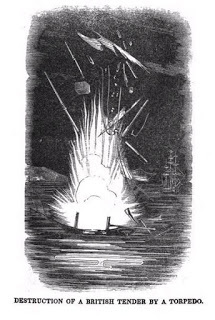 A Bushnell mine exploding
A Bushnell mine exploding
unnerved the British
He tried again in January 1778, this time releasing 20 large kegs loaded with explosives off Bordentown, New Jersey. The kegs were intended to float down the Delaware River and destroy the British fleet at Philadelphia. One mine exploded near a British row boat, killing several sailors. The attack so unnerved the British fleet that it spent the rest of the day shooting up the floating kegs as well as pretty much anything else that floated.. This event was satirized in the poem, “Battle of Kegs,” by Francis Hopkinson. Rebel propaganda painted this as an embarrassment for the hapless Royal Navy. But Bushnell's life as an undersea weapons developer was over.
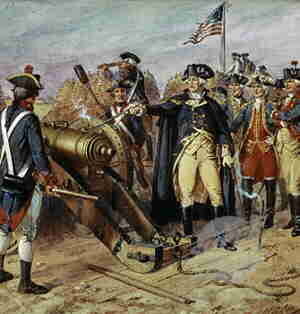 Captain David Bushnell's sappers and miners
Captain David Bushnell's sappers and miners
fought during the siege at Yorktown
The Sapper
Bushnell returned to Saybrook in the spring of 1778. Local Loyalists once detained him but he managed to get released. Later that year Bushnell left the world of maritime warfare and joined the Continental Army when General George Washington named him commander of the first company of sappers and miners at West Point, NY. Captain Bushnell served with competence, for the remainder of the conflict and led the sappers in the siege of Yorktown, the battle that effectively ended the war.. After his discharge from the Continental Army he returned briefly to Connecticut and later spent a brief period in France but returned to the United States to settle in Warrenton, Georgia where he practiced medicine. He died there in 1824.
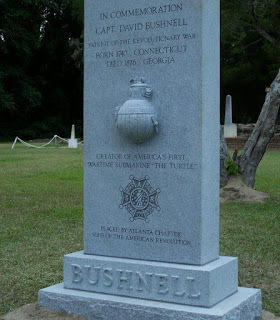 David Bushnell Memorial in Georgia
David Bushnell Memorial in Georgia
Seminal Submariner
In the long run, David Bushnell’s efforts were seminal in the later proliferation of underwater mines, torpedoes and of course, the submarine. His basic use of water for ballast continues to this day, as does use of the propeller. Although his impact on the course of the American War for Independence was marginal, he did have an impact on the long term trajectory of naval warfare. No small feat for a Connecticut Yankee farm boy.
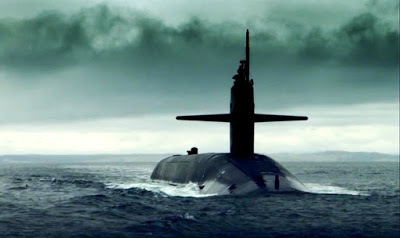 Today's submarines are descendants of Bushnell's
Today's submarines are descendants of Bushnell's
Turtle and still share its basic design, albeit on steroids
So many of our first patriots were accomplished men of letters, lawyers, judges, planters, merchants but relatively few were men of science and technology. David Bushnell falls into the latter category.
Bushnell was born in Saybrook, Connecticut on 30 August 1742, the son of a farmer. He was the first of five children and grew up and worked the family farm near Westbrook. Following the death of his father in 1769, he sold his half interest in the farm to his brother Ezra and entered Yale College in 1771.
 David Bushnell
David BushnellBombs to Boats
While at Yale he became fascinated by the possibility of underwater explosions. An inventive tinkerer by nature, Bushnell successfully combined a black powder charge with a clockwork timing device, thereby creating the first naval mine. He used this knowledge not only in construction of the underwater mine but later in creating floating torpedoes that exploded on contact. He collaborated with the wealthy New Haven inventor and manufacturer Isaac Doolittle to develop the first mechanically triggered time bomb as well as the first screw propeller. As he set about conceiving a practical delivery system for this unique weapon, the onset of the American War for Independence created a new sense of urgency to his efforts. By the fall of that year he had designed and engineered the American Turtle (better known as Turtle), a primitive submarine. He named it Turtle because it looked like two turtle shells lashed together. Not a thing of beauty, but it worked.
 Turtle Design Sketch
Turtle Design SketchTest and Evaluation
 Gen Israel PutnamThis primitive submarine was manned by a single operator who powered it by two hand-cranked screw propellers. A system of water pumps took in and expelled water to control the climb or descent of the craft, which could reach a depth of about 15 feet. To see, the pilot had a small conning tower with several windows. The tower contained a depth gauge and a compass lit by phosphorous. The Turtle’s punch was Bushnell’s original clock/min e combination connected to a a metal drill engineered to bore through the copper sheathing coating the hulls of British warships. Once the mine was attached and released, the timing mechanism engaged leaving the Turtle one hour to escape before 150 pound charge exploded, detonated by a flintlock trigger device. Bushnell arranged a successful demonstration, essentially a “demval” in today’s acquisition parlance. On hand for the event on the Thames River was Connecticut General Israel Putnam, who urged the American government to continue funding for its “full operational capability.”
Gen Israel PutnamThis primitive submarine was manned by a single operator who powered it by two hand-cranked screw propellers. A system of water pumps took in and expelled water to control the climb or descent of the craft, which could reach a depth of about 15 feet. To see, the pilot had a small conning tower with several windows. The tower contained a depth gauge and a compass lit by phosphorous. The Turtle’s punch was Bushnell’s original clock/min e combination connected to a a metal drill engineered to bore through the copper sheathing coating the hulls of British warships. Once the mine was attached and released, the timing mechanism engaged leaving the Turtle one hour to escape before 150 pound charge exploded, detonated by a flintlock trigger device. Bushnell arranged a successful demonstration, essentially a “demval” in today’s acquisition parlance. On hand for the event on the Thames River was Connecticut General Israel Putnam, who urged the American government to continue funding for its “full operational capability.” Turtle Replica
Turtle ReplicaRun Silent, Run Deep - Sorta
History was made in the summer of 1776 when the Turtle made an attack on British fleet anchored in New York harbor under the command of Admiral Richard Howe. Unfortunately, Bushnell became ill and a Sergeant named Erza Lee volunteered in his place. On the night of 6 September a pair of whale boats towed the Turtle off shore where it began its attack. Pumping feverishly, Lee slowly guided the Turtle towards the British fleet. Despite unfair tides, Lee managed to pull up to the mother of all targets, Lord Howe’s own flagship, the 64-gun ship of the line, HMS Eagle. The Turtle’s drill failed to penetrate the hull because it was blocked by an iron bar. With air dwindling, Lee abandoned the efforts and released the mine, which floated free. The mine finally erupted with a tremendous explosion that shot a plume of water into the night air. The unexpected iron bar prevented what could have been a catastrophic kill on a major target, possibly changing British naval tactics for the duration of the war. See my Yankee Doodle Spies post on "The Boat" fore a more detailed discussion of this attack.
 Bushnell's Turtle takes on HMS Eagle
Bushnell's Turtle takes on HMS Eagleand initiates submarine warfare
Torpedoes are Running
Bushnell was undaunted. Confident in his development he continued improving the Turtle. He launched several small attacks against individual British ships but inexperienced pilots and unfavorable tides thwarted each effort. The Turtle was lost the following October when a transport carrying it was sunk by British cannon fire on the North (Hudson) River. Undaunted by all the failure, Bushnell continued tinkering with naval mines and explosives. On 13 August 1777, he released another mine that floated toward the HMS Cerebus, anchored in Black Point Bay. This time the tides were favorable but the device got snagged up with a small schooner. It detonated the explosion killing three British sailors.
 Turtle needed to be towed into attack position by rowboats
Turtle needed to be towed into attack position by rowboatsBattle of the Kegs
 A Bushnell mine exploding
A Bushnell mine explodingunnerved the British
He tried again in January 1778, this time releasing 20 large kegs loaded with explosives off Bordentown, New Jersey. The kegs were intended to float down the Delaware River and destroy the British fleet at Philadelphia. One mine exploded near a British row boat, killing several sailors. The attack so unnerved the British fleet that it spent the rest of the day shooting up the floating kegs as well as pretty much anything else that floated.. This event was satirized in the poem, “Battle of Kegs,” by Francis Hopkinson. Rebel propaganda painted this as an embarrassment for the hapless Royal Navy. But Bushnell's life as an undersea weapons developer was over.
 Captain David Bushnell's sappers and miners
Captain David Bushnell's sappers and minersfought during the siege at Yorktown
The Sapper
Bushnell returned to Saybrook in the spring of 1778. Local Loyalists once detained him but he managed to get released. Later that year Bushnell left the world of maritime warfare and joined the Continental Army when General George Washington named him commander of the first company of sappers and miners at West Point, NY. Captain Bushnell served with competence, for the remainder of the conflict and led the sappers in the siege of Yorktown, the battle that effectively ended the war.. After his discharge from the Continental Army he returned briefly to Connecticut and later spent a brief period in France but returned to the United States to settle in Warrenton, Georgia where he practiced medicine. He died there in 1824.
 David Bushnell Memorial in Georgia
David Bushnell Memorial in GeorgiaSeminal Submariner
In the long run, David Bushnell’s efforts were seminal in the later proliferation of underwater mines, torpedoes and of course, the submarine. His basic use of water for ballast continues to this day, as does use of the propeller. Although his impact on the course of the American War for Independence was marginal, he did have an impact on the long term trajectory of naval warfare. No small feat for a Connecticut Yankee farm boy.
 Today's submarines are descendants of Bushnell's
Today's submarines are descendants of Bushnell'sTurtle and still share its basic design, albeit on steroids
Published on September 28, 2019 14:07
August 31, 2019
Marblehead Men
Sailors become Soldiers who become SailorsOne of the least appreciated units in the Continental Army was also the one that helped save the American cause in actions that provided the backdrop for several iconic commemorative paintings.
The people that live along the rocky New England coast are as hard and flinty as the landscape. At least they were during the time of the Yankee Doodle Spies. Tough and ornery men and women were the first to take real action against the perceived injustices of British rule. I guess carving a civilization out of a weather beaten wilderness requires folks of tough mettle and stubborn ways.
 New England's coast bred tough people
New England's coast bred tough people
Among the toughest and most resourceful of that people were the men who sailed the cold and stormy waters along the North Atlantic coast, fishing, trading and smuggling in weather fair and foul. It is only natural that a militia regiment raised from such stock would prove on of the go-to units of the struggle.
Marblehead Militia
All New England counties and some towns had militia units that formed a long tradition dating back to at least the late 17th century. These units were experienced in several wars fought against native tribes, Canadian neighbors and their French masters.
At the outbreak of the struggle against Britain, the Marblehead militia was one of these. Because it was formed along the rugged New England coast, it naturally was made up of men who spent their civilian lives at sea.
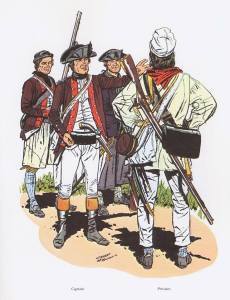 Marblehead Militia
Marblehead Militia
As things came to a head in April 1775, the regiment had the good fortune of gain a commander who would prove as tough and resourceful as the men he led – Colonel John Glover. Under Glover, the regiment marched to Cambridge where they joined the army of New Englanders besieging the British at Boston.
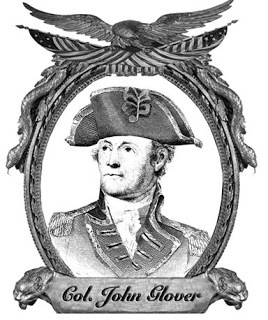
During the siege, Congress created the new Continental Army under the command of General George Washington. The Marblehead Militia, nicknamed “Glover’s Regiment” became part of the Continental Army in June. It was initially termed the 23rd Massachusetts Regiment. Only the best militia units became Continental regiments, the first “professional” army of Americans.
The Continental Line
With their new status came a new name and the Marblehead militia was soon renamed the 14th Massachusetts Continental Line. As a continental regiment, they would now be subject to marching and fighting anywhere the army went, and anywhere George Washington led them. He would soon lead them south to face new dangers and new chances for glory.
Still, the regiment of some 750 sailors would not shed their heritage fully. Unlike other continental regiments, who began to wear similar uniforms of dark blue tunics with white or buff breeches and leggings topped off with a cocked hat, the Marblehead sailors dressed more like, well, sailors. The Marbleheaders wore distinctive blue jackets, white pants and white caps. But it was the skill not the look of these doughty sailors to soldiers that would be their greatest distinction.
Washington’s Navy
As the siege of Boston stretched on, Washington decided he needed a naval force to stem the flow of supplies to the British garrison. He charged the 14th Massachusetts Line with outfitting and manning four schooners for the effort. Glover himself even provided his own schooner, the Hannah. His port at Beverly became the home base of “Washington’s Navy.” Fashioned on a shoestring, the small flotilla of five schooners managed to disrupt the British supply chain while bringing captured supplies to help the Americans. The Marblehead sailors also built most of the defense works that prevented the British from seizing the base.
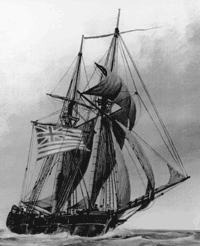 Washington's Navy consisted of
Washington's Navy consisted of
fast schooners manned by experienced sailors
The Miracle on Long Island
Long before it became a traffic nightmare, Long Island was the picturesque and pastoral bread basket of New York. In the summer of 1776 it became the crucible of the British plan to destroy the American rebellion.
Driven from Boston earlier that year, Lord William Howe’s reinforced army of over twenty thousand sailed into New York harbor and landed at Staten Island. Soon he transported his army across the water and quickly bottled George Washington’s forces along the heights of Brooklyn. Although there was fierce fighting, the British numbers and well placed guns made Washington’s hold on the island a liability. He was faced with a forlorn defense and certain destruction, or try to escape.
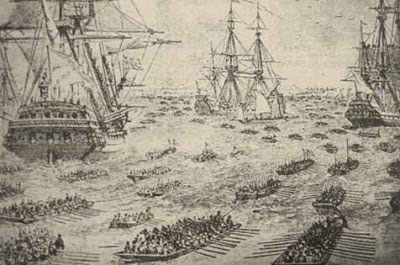 British Landing at Long Island would soon threaten the
British Landing at Long Island would soon threaten the
American Army and the cause
In a way, the latter was the hardest choice. The British naval power was even more overwhelming than their land forces. To cross in the face of these two elements would lead to certain disaster. But when a sudden fog descended over New York harbor on the night of August 29th, Washington was given a short window to act.
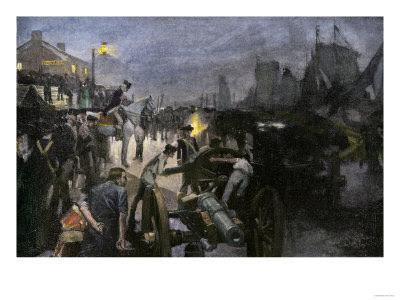
So under the cover of darkness and a shroud of fog, he made the gambit and moved his army in the face of the enemy. His instrument was the 14th Massachusetts’ sailor-soldiers. For hour after hour Glover’s men rowed boat after boat, transporting soldiers, horses and what equipment they could take without alerting the British who waited just a few hundred yards distant.
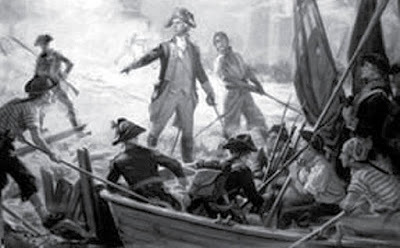 Glover worked his men through the night to save an army
Glover worked his men through the night to save an army
Despite the dark and the fog, the Marblehead men navigated flawlessly and silently. A splash or the bumping of boat against boat could easily have alerted the Royal Navy whose warships lay in anchor nearby. By the next morning, they had transported some 9,000 men from the jaws of the British lion to the temporary safety of Manhattan.
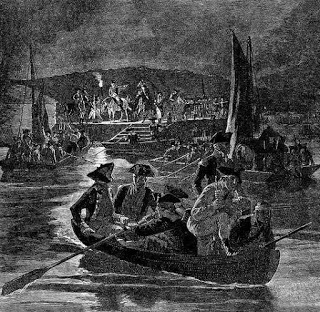 The miracle retreat from LI saved the army and the cause
The miracle retreat from LI saved the army and the cause
A War of Maneuver
The regiment’s utility was display throughout the “war of maneuver” that had Washington scurrying from one position to another to avoid destruction by the British. Glover’s men delayed the British advance at Kips Bay, gaining time for the rest of the army to escape to the safety of Harlem.
As the campaign shifted north to Westchester, the regiment once more played a critical role – this time as soldier-sailors.
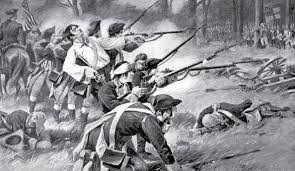 Glover's sailors to soldiers stymie the British at Pelham
Glover's sailors to soldiers stymie the British at Pelham
On October 13th, a force of some 4,000 British and Hessians pushed inland from Pelham Bay. But along the stone walls intersecting the farmland waited the 750 men of the 14th Massachusetts and John Glover. They fought the British to a standstill, trading space for time and allowing the Continental Army to prepare for this new onslaught. Scouting and raiding, Glover’s men proved they were as adept with stone and earth under their feet as the wooden decks of their schooners. They captured supplies and enemy prisoners and then helped man the artillery when Washington and Howe clashed at White Plains.
The Crossing that Shocked the World
By December of that year, a battered and greatly reduced Continental Army reached the end of its tether as it stared across the Delaware River. Just hours behind the advanced guard of a British column led by Major General Charles Cornwallis was closing fast. The Marblehead men gathered up anything that floated for miles up and down the river and then quickly ferried the ragtag army to safety.
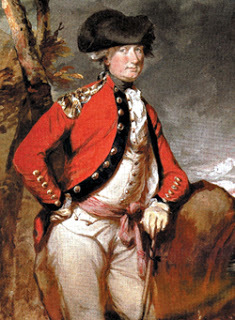 Gen Charles Cornwallis nearly bagged
Gen Charles Cornwallis nearly bagged
Washington but for the Marblehead Regt.
But their greatest challenge lay ahead. With enlistments dwindling with a new year that was just days away, Washington had short window to do something with his army besides hightail from the redcoats. General Howe gave him the opportunity. Thinking the Americans beaten, he scattered his army into winter quarter garrisons, leaving just a few isolated brigades in West Jersey.
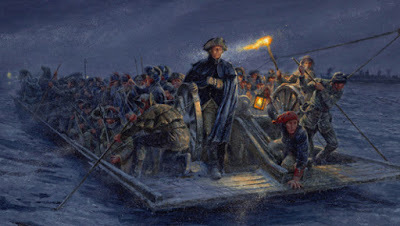 The Glover Regiment bringing Washington to destiny
The Glover Regiment bringing Washington to destiny
Washington turned to Glover’s men once more. In another secret night time operation, Washington called on the seasoned sailors to man a different kind of boat. Long and sleek, the Durham boats were propelled by digging long poles into the river bottom. In a night of snow mixed with rain, file after file of Continentals, ill clad, poorly fed but determined, silently piled into the boats under the watchful eyes of the sailors. Through the night powerful arms dug staffs into the swirling water. Strong legs and backs moved the boats, brimming with men and equipment, across the fast moving current and to the dark and danger of the jersey side. Despite the ice flows, Glover’s sailors managed to ferry over 2,000 troops and 18 guns.
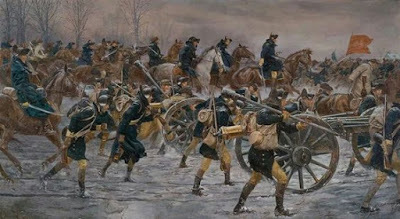 Sailors to soldiers as Glover's Marblehead Regiment
Sailors to soldiers as Glover's Marblehead Regiment
joins the night march on Trenton
But their work was not finished. The sailors now switched to soldiers and marched the harrowing nine miles to Trenton, fighting well in the short battle that shocked the world and saved the cause. Their last act was to take the army back across the river, for their enlistments too were up and the regiment disbanded.
Down to the Sea in Ships
Glover stayed on with the Continental Army but his men went home. New England was never a major theater for the rest of the struggle, but it played a critical role nonetheless – supplying the cause and striking the British at sea. Glover’s veteran soldiers now turned to sailors once more, in a different type of war, less dramatic but also quite devastating to the British.
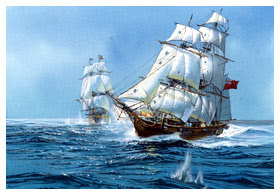 Privateers devastated British merchant shipping and tied down
Privateers devastated British merchant shipping and tied down
the Royal Navy
Some took up smuggling, a critical means of supplying the war effort. Others went a step further and turned to privateering, taking on British merchant vessels in a war that deprived the British of wealth and sustenance, while bolstering America’s scarce resources. The Marblehead men played no insignificant role in taking the more than 3,000 vessels captured during the war.
The people that live along the rocky New England coast are as hard and flinty as the landscape. At least they were during the time of the Yankee Doodle Spies. Tough and ornery men and women were the first to take real action against the perceived injustices of British rule. I guess carving a civilization out of a weather beaten wilderness requires folks of tough mettle and stubborn ways.
 New England's coast bred tough people
New England's coast bred tough peopleAmong the toughest and most resourceful of that people were the men who sailed the cold and stormy waters along the North Atlantic coast, fishing, trading and smuggling in weather fair and foul. It is only natural that a militia regiment raised from such stock would prove on of the go-to units of the struggle.
Marblehead Militia
All New England counties and some towns had militia units that formed a long tradition dating back to at least the late 17th century. These units were experienced in several wars fought against native tribes, Canadian neighbors and their French masters.
At the outbreak of the struggle against Britain, the Marblehead militia was one of these. Because it was formed along the rugged New England coast, it naturally was made up of men who spent their civilian lives at sea.
 Marblehead Militia
Marblehead MilitiaAs things came to a head in April 1775, the regiment had the good fortune of gain a commander who would prove as tough and resourceful as the men he led – Colonel John Glover. Under Glover, the regiment marched to Cambridge where they joined the army of New Englanders besieging the British at Boston.

During the siege, Congress created the new Continental Army under the command of General George Washington. The Marblehead Militia, nicknamed “Glover’s Regiment” became part of the Continental Army in June. It was initially termed the 23rd Massachusetts Regiment. Only the best militia units became Continental regiments, the first “professional” army of Americans.
The Continental Line
With their new status came a new name and the Marblehead militia was soon renamed the 14th Massachusetts Continental Line. As a continental regiment, they would now be subject to marching and fighting anywhere the army went, and anywhere George Washington led them. He would soon lead them south to face new dangers and new chances for glory.
Still, the regiment of some 750 sailors would not shed their heritage fully. Unlike other continental regiments, who began to wear similar uniforms of dark blue tunics with white or buff breeches and leggings topped off with a cocked hat, the Marblehead sailors dressed more like, well, sailors. The Marbleheaders wore distinctive blue jackets, white pants and white caps. But it was the skill not the look of these doughty sailors to soldiers that would be their greatest distinction.
Washington’s Navy
As the siege of Boston stretched on, Washington decided he needed a naval force to stem the flow of supplies to the British garrison. He charged the 14th Massachusetts Line with outfitting and manning four schooners for the effort. Glover himself even provided his own schooner, the Hannah. His port at Beverly became the home base of “Washington’s Navy.” Fashioned on a shoestring, the small flotilla of five schooners managed to disrupt the British supply chain while bringing captured supplies to help the Americans. The Marblehead sailors also built most of the defense works that prevented the British from seizing the base.
 Washington's Navy consisted of
Washington's Navy consisted offast schooners manned by experienced sailors
The Miracle on Long Island
Long before it became a traffic nightmare, Long Island was the picturesque and pastoral bread basket of New York. In the summer of 1776 it became the crucible of the British plan to destroy the American rebellion.
Driven from Boston earlier that year, Lord William Howe’s reinforced army of over twenty thousand sailed into New York harbor and landed at Staten Island. Soon he transported his army across the water and quickly bottled George Washington’s forces along the heights of Brooklyn. Although there was fierce fighting, the British numbers and well placed guns made Washington’s hold on the island a liability. He was faced with a forlorn defense and certain destruction, or try to escape.
 British Landing at Long Island would soon threaten the
British Landing at Long Island would soon threaten theAmerican Army and the cause
In a way, the latter was the hardest choice. The British naval power was even more overwhelming than their land forces. To cross in the face of these two elements would lead to certain disaster. But when a sudden fog descended over New York harbor on the night of August 29th, Washington was given a short window to act.

So under the cover of darkness and a shroud of fog, he made the gambit and moved his army in the face of the enemy. His instrument was the 14th Massachusetts’ sailor-soldiers. For hour after hour Glover’s men rowed boat after boat, transporting soldiers, horses and what equipment they could take without alerting the British who waited just a few hundred yards distant.
 Glover worked his men through the night to save an army
Glover worked his men through the night to save an armyDespite the dark and the fog, the Marblehead men navigated flawlessly and silently. A splash or the bumping of boat against boat could easily have alerted the Royal Navy whose warships lay in anchor nearby. By the next morning, they had transported some 9,000 men from the jaws of the British lion to the temporary safety of Manhattan.
 The miracle retreat from LI saved the army and the cause
The miracle retreat from LI saved the army and the causeA War of Maneuver
The regiment’s utility was display throughout the “war of maneuver” that had Washington scurrying from one position to another to avoid destruction by the British. Glover’s men delayed the British advance at Kips Bay, gaining time for the rest of the army to escape to the safety of Harlem.
As the campaign shifted north to Westchester, the regiment once more played a critical role – this time as soldier-sailors.
 Glover's sailors to soldiers stymie the British at Pelham
Glover's sailors to soldiers stymie the British at PelhamOn October 13th, a force of some 4,000 British and Hessians pushed inland from Pelham Bay. But along the stone walls intersecting the farmland waited the 750 men of the 14th Massachusetts and John Glover. They fought the British to a standstill, trading space for time and allowing the Continental Army to prepare for this new onslaught. Scouting and raiding, Glover’s men proved they were as adept with stone and earth under their feet as the wooden decks of their schooners. They captured supplies and enemy prisoners and then helped man the artillery when Washington and Howe clashed at White Plains.
The Crossing that Shocked the World
By December of that year, a battered and greatly reduced Continental Army reached the end of its tether as it stared across the Delaware River. Just hours behind the advanced guard of a British column led by Major General Charles Cornwallis was closing fast. The Marblehead men gathered up anything that floated for miles up and down the river and then quickly ferried the ragtag army to safety.
 Gen Charles Cornwallis nearly bagged
Gen Charles Cornwallis nearly baggedWashington but for the Marblehead Regt.
But their greatest challenge lay ahead. With enlistments dwindling with a new year that was just days away, Washington had short window to do something with his army besides hightail from the redcoats. General Howe gave him the opportunity. Thinking the Americans beaten, he scattered his army into winter quarter garrisons, leaving just a few isolated brigades in West Jersey.
 The Glover Regiment bringing Washington to destiny
The Glover Regiment bringing Washington to destinyWashington turned to Glover’s men once more. In another secret night time operation, Washington called on the seasoned sailors to man a different kind of boat. Long and sleek, the Durham boats were propelled by digging long poles into the river bottom. In a night of snow mixed with rain, file after file of Continentals, ill clad, poorly fed but determined, silently piled into the boats under the watchful eyes of the sailors. Through the night powerful arms dug staffs into the swirling water. Strong legs and backs moved the boats, brimming with men and equipment, across the fast moving current and to the dark and danger of the jersey side. Despite the ice flows, Glover’s sailors managed to ferry over 2,000 troops and 18 guns.
 Sailors to soldiers as Glover's Marblehead Regiment
Sailors to soldiers as Glover's Marblehead Regimentjoins the night march on Trenton
But their work was not finished. The sailors now switched to soldiers and marched the harrowing nine miles to Trenton, fighting well in the short battle that shocked the world and saved the cause. Their last act was to take the army back across the river, for their enlistments too were up and the regiment disbanded.
Down to the Sea in Ships
Glover stayed on with the Continental Army but his men went home. New England was never a major theater for the rest of the struggle, but it played a critical role nonetheless – supplying the cause and striking the British at sea. Glover’s veteran soldiers now turned to sailors once more, in a different type of war, less dramatic but also quite devastating to the British.
 Privateers devastated British merchant shipping and tied down
Privateers devastated British merchant shipping and tied downthe Royal Navy
Some took up smuggling, a critical means of supplying the war effort. Others went a step further and turned to privateering, taking on British merchant vessels in a war that deprived the British of wealth and sustenance, while bolstering America’s scarce resources. The Marblehead men played no insignificant role in taking the more than 3,000 vessels captured during the war.
Published on August 31, 2019 14:57
July 19, 2019
A General Disaster
This edition of the Yankee Doodle Spies switches from the Loyalists to an Englishman. But this Englishman, an actual professional officer, came to America when his British military career stalled. Settling in Winchester, Virginia in 1773, Lieutenant Colonel Charles Lee took up Whig/patriot politics and, due to his experience in the regular army, was named second in command to General George Washington. It is more than an understatement to call Lee controversial, odd, ambitious, and of uncertain morals. But I digress. Rather than profile his entire career – it is too delicious to squander on one post, I thought we would look at his “evening parade.”
Early Career at a Glance
Lee was a well-educated son of a (not so modern) major general. After attending school in Switzerland he entered the Royal Army as an ensign in 1747. Like the rest of his generation of soldiers and sailors, he saw a lot of action as Britain had no shortage of wars in the mid eighteenth century.
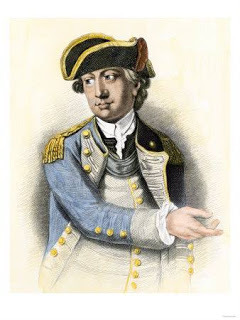 Major General Charles Lee
Major General Charles Lee
His exploits in the Seven Years War, actually the French and Indian War, took him from Braddock’s defeat on the Monongahela to the final victory on the Plains of Abraham. He ended the war a major and returned to Europe where he served briefly as a lieutenant colonel in the Portuguese Army and later in the Polish service. In the latter he managed to lose two fingers in a duel in which his opponent died. Lee was no snowflake.
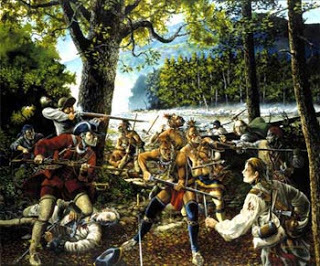 Lee was a Seven Year and French and Indian War Veteran
Lee was a Seven Year and French and Indian War Veteran
With his career in the Royal Army at nadir he moved to North America to take up planting and politics. When the American Revolution broke out he was on the list of prospects to lead the new American army. He lost to George Washington but received the consolation prize of second in command. Major General Lee proved talented yet cantankerous and involved himself in as many intrigues as engagements. He was a seducer of women, but quirky, disheveled and followed by his pack of dogs wherever he went. Captured under mysterious circumstances as America’s fortunes waned in late 1776, Lee was suspected by many of aiding his British captors, who exploited him.
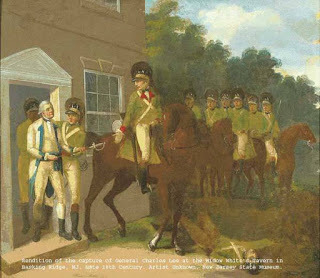 Lee was captured at Basking Ridge NJ
Lee was captured at Basking Ridge NJ
while away from his army
Renewal and Redemption
Lee was paroled as part of a prisoner exchange in April 1778, being swapped for British General Richard Prescott. Despite suspicions of duplicity and back-stabbing by Lee, George Washington welcomed him home to the Continental Army like a prodigal son. Circumstances placed the quirky but still considered professional officer in a position to make up for any past quirks, obfuscations and manipulations. The Continental Army emerged from Valley Forge as a revitalized force, professionally trained and equipped. British actions would provide Charles Lee a chance to use that new force and prove once and for all he was the best officer in the army, a view long held by Lee and his supporters.
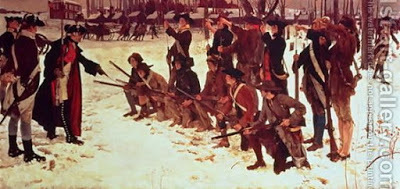 The Continental Army emerged from Valley Forge
The Continental Army emerged from Valley Forge
as well trained professionals
General Clinton’s Gift
By spring 1778 the British had decided to abandon the American capital and concentrate their forces in the great stronghold of New York. This would allow London to divert land and naval forces to the new active theater in the west Indies. Clinton sent part of his forces north by sea but a substantial force would have to march north across the steamy fields of the Jerseys before they could meet transports to carry them to New York. Washington’s spies alerted him to this and he positioned the Continental Army to take advantage of Clinton’s dilemma. A lumbering land force, reduced in numbers, presented a juicy target for the commander in chief. Clinton had presented the long suffering Continentals with a gift.
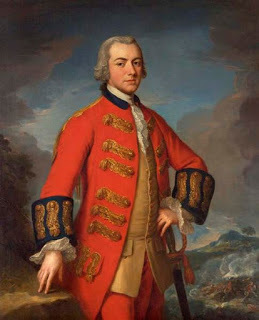 Sir Henry Clinton
Sir Henry Clinton
Councils of War
At a series of councils of war, Washington tried to determine the best course of action. Risk an all-out attack? Shadow the British and harass their move? Attempt to block them and force a British assault?
The final session came on 24 June. Many wanted to take strong action against the British, but the generals were split on how. Marquis de Lafayette made it a matter of honor to strike at the British. Nathanael Greene urged a partial action as a symbolic morale building effort. The aggressive “Mad” Anthony Wayne favored an all-out fight. But Lee made it clear he wanted merely to observe the British army make its way back.
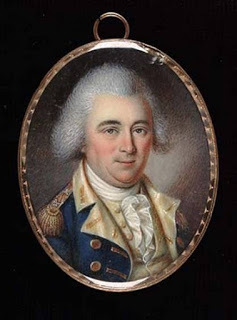 Mad Anthony Wayne
Mad Anthony Wayne
The quirky, self-aggrandizing Lee offered remarkably measured advice and had a good grasp of the hazards involved. Lee felt an all-out attack on the British absurd and that defeat for the Americans would prove disastrous. In fairness he probably did not grasp the fact that this army was unlike any command – the American army of the past. Washington decided to continue to harass the British. His combative, young aide Alexander Hamilton dryly commented that the results of this meeting "would have done honor to the most honorable body of midwives and to them only."
To Lead or Not to Lead
Events gave Washington pause. The New Jersey militia under General Philemon Dickinson (see the Yankee Doodle Spies post on the Militia General) slowed and harassed the British column was already being plagued by New Jersey militia who were blocking the roads and staging nuisance attacks.
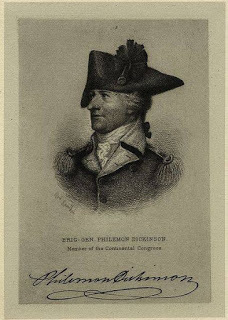 Major General Philemon Dickinson
Major General Philemon Dickinson
Seeking to capitalize on this, Washington dispatched and advanced guard of six hundred riflemen under famed Colonel Dan Morgan, and then piled on with a second detachment of 1,440 picked Continentals. He then sent a third wave of a thousand picked men led by Wayne. Washington asked his newly returned second in command, Charles Lee, to lead this strike force but Lee demurred. Did he feel taking on the British in this manner too risky or that the command was beneath him?
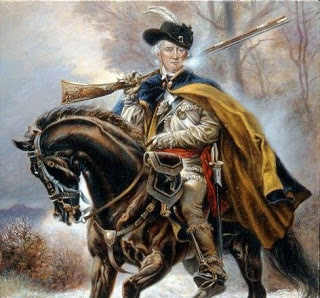 Dan Morgan
Dan Morgan
Lafayette, I am Here
So Washington turned to one of his favorites – the Marquis de Lafayette, the youthful French aristocrat who accepted the command. But Lee then had second thoughts and demanded command of the force. Washington felt he had no choice but accede. However, he plussed-up the force by another six hundred men as a rationale for replacing Lafayette. Now a force of some 5,000 were closing on the British rear.
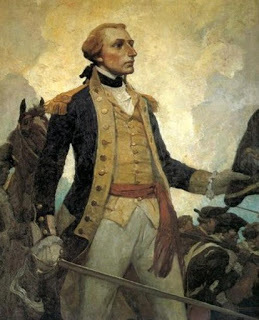 Marquis de Lafayette
Marquis de Lafayette
A final war council on 27 June cleared up little as to how hard to hit the British, who were closing on Monmouth Court House en-route to a Sandy Hook rendezvous with the fleet. Lee and the strike force slowly staged near the British rear guard. Several messages from Washington provided home no clear guidance on what to do. So Lee determined his own approach: watchful waiting.
His placement of forces was irregular, making it difficult for mutual support. On the 28th of June he advanced cautiously. with Anthony Wayne's brigade in the lead. The day was hot with stifling humidity that soaked coats red and blue.When the initial contact on 28 June caught the British rear guard off balance, Anthony Wayne pushed for a more aggressive posture, as was his way. (See the Yankee Doodle Spies post on The Mad Man) But without firm orders, Lee demurred. The chance to jump the British rear guard was lost.
Baptism by Fire
But learning of the contact, General Clinton, meanwhile, decided to give the rebels one last lesson. He reinforced his rear guard and sent them south after their pursuers. Lee’s situational awareness was confused. He had conflicting reports on British strength and activities. But he decided to fix the British rear guard to his front. If he could find them. He sent forward Wayne’s force but Wayne circled around the British left to attempt and ambush. Wayne was surprised by a detachment of dragoons and firing erupted. Lee had to change plans. He pushed Lafayette forward and maneuvered to take advantage of Wayne’s situation.
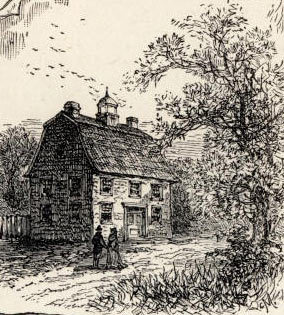 Old Monmouth Courthouse
Old Monmouth Courthouse
Run Away, Run Away Run
Then Clinton sprang his surprise on the rebels and launched the grenadiers against Lee’s right. Confusion ensued. A series of firefights broke out. Volleys flung lead balls across steamy farm fields. Guns began belching heavy iron balls across meadows and fields. Lee’s situational awareness rapidly deteriorated. He did not know what was against him and he did not have his own forces well in hand. Lacking firm orders from Lee, his brigades maneuvered independently in reaction to the situation as they saw it. Normally that is not totally bad. Initiative in combat is a good thing. But this led to the makings of disaster. as the formations were not working together, ,but independently.
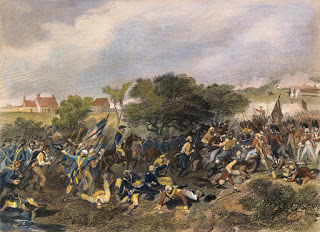 Lee's units operated independently against
Lee's units operated independently against
the British
Fearing the worst - a general engagement he seeked to avoid, Lee retreated three times. His goal was to extract his forces from a bad situation and avoid the grasp of the British regulars with the army's most elite infantry and cavalry. Puzzled by the withdrawals,soldiers and commanders began to lose heart. Was something going wrong that they did not know? The fog of battle caused the retrograde to take on the look and feel of a rout. These were perhaps understandable actions considering the situation before him. But he made one cardinal error. He did not keep the commander in chief informed.
You May Leave the Army
To the rear Washington was advancing with his staff through a stand of woods. Suddenly he saw a civilian and a fifer coming down the road. He disbelieved them when told the army was in retreat. Then stragglers bereft of gear and weapons staggered ny. Then an entire unit was seen running away from the front. Washington, now enraged, rallied the men and spurred forward. Soon he saw an officer on horseback ostensibly fleeing the battle. It turned out to be Charles Lee.
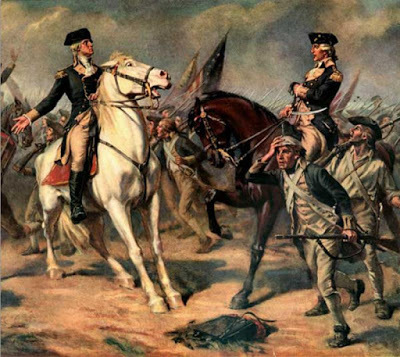 Washington confronts Lee
Washington confronts Lee
“What is all this?” Washington demanded. Lee hesitated at first. Lee then blurted out a series of incoherent defensive statements about intelligence and the power of the British. That did not go over well. Washington insisted they were facing only a strong covering party of the enemy. Lee replied that the British had greater numbers than previously thought and did not think it was proper to risk the army. Washington exploded with a tirade that no one had previously witnessed, calling Lee’s fortitude into question. Washington broke off the exchange when he spotted some more units retreating and hurried over to rally them. Lee appears to have remained in stunned silence for a few minutes.
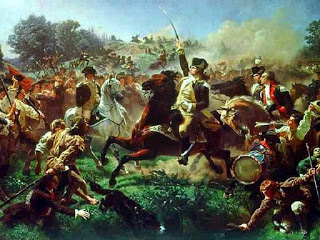 Washington managed to rally the army
Washington managed to rally the army
Washington, meanwhile rallied the retreating troops, regrouped his forces and fought Clinton’s regulars to a standstill. The fighting went back and forth as neither side would concede. Despite the burning summer heat, both sides unleashed musket volleys and thunderous artillery The savage day's fighting ebbed with the dark of the night and both armies collapsed where they fought and slept on their arms. But when the Americans stood to at dawn they found the entire British had beat feet to Sandy Hook and the safety of the fleet. Although sort of a moral victory, Washington was vexed at losing a chance to crush the enemy.
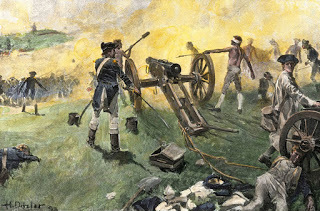 The Americans stood their own against British assaults
The Americans stood their own against British assaults
The End of the Affair
By the 29th, Washington returned to matter of Lee and his conduct. In a series of letters, Lee grew petulant and unremorseful. When confronted by Washington on his reason for the withdrawal, the two men exchanged words. Demanding the satisfaction of a hearing, Lee was brought up on formal charges of insubordination. A court martial convened over several weeks. Lee was convicted of dereliction and cowardice. His sentence: removal from command in the army for one year. Unsatisfied with the result, Lee got embroiled in several affairs of honor and often criticized the Continental Congress for enforcing the sentence on him. These actions led to his permanent dismissal from the Continental Army in January of 1780.
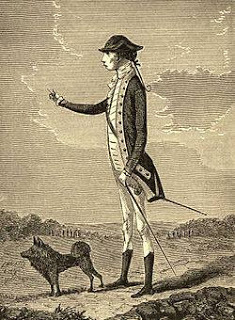 Lee once advised he liked his dogs better than
Lee once advised he liked his dogs better than
people
Retrospective
Charles Lee’s quirky personality, arrogance and narcissism made him very controversial. Yet for most of the war he was admired by many in the army and in Congress for his experience and professionalism. He has a mixed record though and there were times his loyalty was suspect. But his actions at Monmouth were the result of his awe of the British professionals, fear of getting decisively engaged and confusion in the fog of battle. I also suspect he was done in by a lack of respect for Washington, chemistry with his subordinates commanders and confidence in the American soldiers under him. Of these, the third was his greatest failure.
Early Career at a Glance
Lee was a well-educated son of a (not so modern) major general. After attending school in Switzerland he entered the Royal Army as an ensign in 1747. Like the rest of his generation of soldiers and sailors, he saw a lot of action as Britain had no shortage of wars in the mid eighteenth century.
 Major General Charles Lee
Major General Charles LeeHis exploits in the Seven Years War, actually the French and Indian War, took him from Braddock’s defeat on the Monongahela to the final victory on the Plains of Abraham. He ended the war a major and returned to Europe where he served briefly as a lieutenant colonel in the Portuguese Army and later in the Polish service. In the latter he managed to lose two fingers in a duel in which his opponent died. Lee was no snowflake.
 Lee was a Seven Year and French and Indian War Veteran
Lee was a Seven Year and French and Indian War VeteranWith his career in the Royal Army at nadir he moved to North America to take up planting and politics. When the American Revolution broke out he was on the list of prospects to lead the new American army. He lost to George Washington but received the consolation prize of second in command. Major General Lee proved talented yet cantankerous and involved himself in as many intrigues as engagements. He was a seducer of women, but quirky, disheveled and followed by his pack of dogs wherever he went. Captured under mysterious circumstances as America’s fortunes waned in late 1776, Lee was suspected by many of aiding his British captors, who exploited him.
 Lee was captured at Basking Ridge NJ
Lee was captured at Basking Ridge NJwhile away from his army
Renewal and Redemption
Lee was paroled as part of a prisoner exchange in April 1778, being swapped for British General Richard Prescott. Despite suspicions of duplicity and back-stabbing by Lee, George Washington welcomed him home to the Continental Army like a prodigal son. Circumstances placed the quirky but still considered professional officer in a position to make up for any past quirks, obfuscations and manipulations. The Continental Army emerged from Valley Forge as a revitalized force, professionally trained and equipped. British actions would provide Charles Lee a chance to use that new force and prove once and for all he was the best officer in the army, a view long held by Lee and his supporters.
 The Continental Army emerged from Valley Forge
The Continental Army emerged from Valley Forge as well trained professionals
General Clinton’s Gift
By spring 1778 the British had decided to abandon the American capital and concentrate their forces in the great stronghold of New York. This would allow London to divert land and naval forces to the new active theater in the west Indies. Clinton sent part of his forces north by sea but a substantial force would have to march north across the steamy fields of the Jerseys before they could meet transports to carry them to New York. Washington’s spies alerted him to this and he positioned the Continental Army to take advantage of Clinton’s dilemma. A lumbering land force, reduced in numbers, presented a juicy target for the commander in chief. Clinton had presented the long suffering Continentals with a gift.
 Sir Henry Clinton
Sir Henry ClintonCouncils of War
At a series of councils of war, Washington tried to determine the best course of action. Risk an all-out attack? Shadow the British and harass their move? Attempt to block them and force a British assault?
The final session came on 24 June. Many wanted to take strong action against the British, but the generals were split on how. Marquis de Lafayette made it a matter of honor to strike at the British. Nathanael Greene urged a partial action as a symbolic morale building effort. The aggressive “Mad” Anthony Wayne favored an all-out fight. But Lee made it clear he wanted merely to observe the British army make its way back.
 Mad Anthony Wayne
Mad Anthony WayneThe quirky, self-aggrandizing Lee offered remarkably measured advice and had a good grasp of the hazards involved. Lee felt an all-out attack on the British absurd and that defeat for the Americans would prove disastrous. In fairness he probably did not grasp the fact that this army was unlike any command – the American army of the past. Washington decided to continue to harass the British. His combative, young aide Alexander Hamilton dryly commented that the results of this meeting "would have done honor to the most honorable body of midwives and to them only."
To Lead or Not to Lead
Events gave Washington pause. The New Jersey militia under General Philemon Dickinson (see the Yankee Doodle Spies post on the Militia General) slowed and harassed the British column was already being plagued by New Jersey militia who were blocking the roads and staging nuisance attacks.
 Major General Philemon Dickinson
Major General Philemon DickinsonSeeking to capitalize on this, Washington dispatched and advanced guard of six hundred riflemen under famed Colonel Dan Morgan, and then piled on with a second detachment of 1,440 picked Continentals. He then sent a third wave of a thousand picked men led by Wayne. Washington asked his newly returned second in command, Charles Lee, to lead this strike force but Lee demurred. Did he feel taking on the British in this manner too risky or that the command was beneath him?
 Dan Morgan
Dan MorganLafayette, I am Here
So Washington turned to one of his favorites – the Marquis de Lafayette, the youthful French aristocrat who accepted the command. But Lee then had second thoughts and demanded command of the force. Washington felt he had no choice but accede. However, he plussed-up the force by another six hundred men as a rationale for replacing Lafayette. Now a force of some 5,000 were closing on the British rear.
 Marquis de Lafayette
Marquis de LafayetteA final war council on 27 June cleared up little as to how hard to hit the British, who were closing on Monmouth Court House en-route to a Sandy Hook rendezvous with the fleet. Lee and the strike force slowly staged near the British rear guard. Several messages from Washington provided home no clear guidance on what to do. So Lee determined his own approach: watchful waiting.
His placement of forces was irregular, making it difficult for mutual support. On the 28th of June he advanced cautiously. with Anthony Wayne's brigade in the lead. The day was hot with stifling humidity that soaked coats red and blue.When the initial contact on 28 June caught the British rear guard off balance, Anthony Wayne pushed for a more aggressive posture, as was his way. (See the Yankee Doodle Spies post on The Mad Man) But without firm orders, Lee demurred. The chance to jump the British rear guard was lost.
Baptism by Fire
But learning of the contact, General Clinton, meanwhile, decided to give the rebels one last lesson. He reinforced his rear guard and sent them south after their pursuers. Lee’s situational awareness was confused. He had conflicting reports on British strength and activities. But he decided to fix the British rear guard to his front. If he could find them. He sent forward Wayne’s force but Wayne circled around the British left to attempt and ambush. Wayne was surprised by a detachment of dragoons and firing erupted. Lee had to change plans. He pushed Lafayette forward and maneuvered to take advantage of Wayne’s situation.
 Old Monmouth Courthouse
Old Monmouth Courthouse Run Away, Run Away Run
Then Clinton sprang his surprise on the rebels and launched the grenadiers against Lee’s right. Confusion ensued. A series of firefights broke out. Volleys flung lead balls across steamy farm fields. Guns began belching heavy iron balls across meadows and fields. Lee’s situational awareness rapidly deteriorated. He did not know what was against him and he did not have his own forces well in hand. Lacking firm orders from Lee, his brigades maneuvered independently in reaction to the situation as they saw it. Normally that is not totally bad. Initiative in combat is a good thing. But this led to the makings of disaster. as the formations were not working together, ,but independently.
 Lee's units operated independently against
Lee's units operated independently againstthe British
Fearing the worst - a general engagement he seeked to avoid, Lee retreated three times. His goal was to extract his forces from a bad situation and avoid the grasp of the British regulars with the army's most elite infantry and cavalry. Puzzled by the withdrawals,soldiers and commanders began to lose heart. Was something going wrong that they did not know? The fog of battle caused the retrograde to take on the look and feel of a rout. These were perhaps understandable actions considering the situation before him. But he made one cardinal error. He did not keep the commander in chief informed.
You May Leave the Army
To the rear Washington was advancing with his staff through a stand of woods. Suddenly he saw a civilian and a fifer coming down the road. He disbelieved them when told the army was in retreat. Then stragglers bereft of gear and weapons staggered ny. Then an entire unit was seen running away from the front. Washington, now enraged, rallied the men and spurred forward. Soon he saw an officer on horseback ostensibly fleeing the battle. It turned out to be Charles Lee.
 Washington confronts Lee
Washington confronts Lee“What is all this?” Washington demanded. Lee hesitated at first. Lee then blurted out a series of incoherent defensive statements about intelligence and the power of the British. That did not go over well. Washington insisted they were facing only a strong covering party of the enemy. Lee replied that the British had greater numbers than previously thought and did not think it was proper to risk the army. Washington exploded with a tirade that no one had previously witnessed, calling Lee’s fortitude into question. Washington broke off the exchange when he spotted some more units retreating and hurried over to rally them. Lee appears to have remained in stunned silence for a few minutes.
 Washington managed to rally the army
Washington managed to rally the armyWashington, meanwhile rallied the retreating troops, regrouped his forces and fought Clinton’s regulars to a standstill. The fighting went back and forth as neither side would concede. Despite the burning summer heat, both sides unleashed musket volleys and thunderous artillery The savage day's fighting ebbed with the dark of the night and both armies collapsed where they fought and slept on their arms. But when the Americans stood to at dawn they found the entire British had beat feet to Sandy Hook and the safety of the fleet. Although sort of a moral victory, Washington was vexed at losing a chance to crush the enemy.
 The Americans stood their own against British assaults
The Americans stood their own against British assaultsThe End of the Affair
By the 29th, Washington returned to matter of Lee and his conduct. In a series of letters, Lee grew petulant and unremorseful. When confronted by Washington on his reason for the withdrawal, the two men exchanged words. Demanding the satisfaction of a hearing, Lee was brought up on formal charges of insubordination. A court martial convened over several weeks. Lee was convicted of dereliction and cowardice. His sentence: removal from command in the army for one year. Unsatisfied with the result, Lee got embroiled in several affairs of honor and often criticized the Continental Congress for enforcing the sentence on him. These actions led to his permanent dismissal from the Continental Army in January of 1780.
 Lee once advised he liked his dogs better than
Lee once advised he liked his dogs better thanpeople
Retrospective
Charles Lee’s quirky personality, arrogance and narcissism made him very controversial. Yet for most of the war he was admired by many in the army and in Congress for his experience and professionalism. He has a mixed record though and there were times his loyalty was suspect. But his actions at Monmouth were the result of his awe of the British professionals, fear of getting decisively engaged and confusion in the fog of battle. I also suspect he was done in by a lack of respect for Washington, chemistry with his subordinates commanders and confidence in the American soldiers under him. Of these, the third was his greatest failure.
Published on July 19, 2019 09:55
June 2, 2019
The 2nd Baronet of New York
Sir John Johnson
It is somewhat rare to run back to back profiles of Loyalists but I have been meaning to profile a member of a family that defined British – native relations in the mid to late 18th century, Sir John Johnson. John Johnson's father was the famed Agent of the crown to the Indians of New York. In that capacity, Sir William Johnson, 1st Baronet of New York, was the key interlocutor for British interests and managed to establish pretty good relations between the settlers and the Iroquois nations in central New York. This was no easy undertaking as the migrants from New England and other points east had a thirst for land and the Iroquois had a thirst for, well suffice to say they were the most fearsome warriors of their day and not to be trifled with. William Johnson’s passing and the outbreak of the American Revolution ignited a final struggle between these forces.
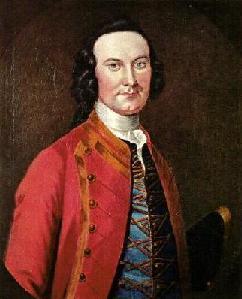 Sir William Johnson, 1st Baronet of New York
Sir William Johnson, 1st Baronet of New York
Thrust into this frontier cauldron was Johnson’s heir and reluctant interlocutor, John Johnson, 2nd Baronet of New York. The younger Johnson was born 5 Nov. 1741 at Mount Johnson near New Amsterdam, New York. His mother was a local woman of Dutch extraction, Catherine Wysenberk.
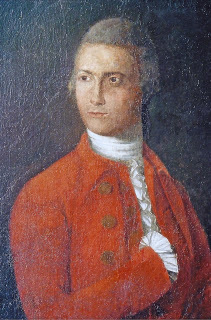 Sir John Johnson, 2nd Baronet
Sir John Johnson, 2nd Baronet
French & Indian Fighter
John Johnson spent most of his childhood at Fort Johnson on the Mohawk River. After briefly attending Benjamin Franklin’s College and Academy in Philadelphia in 1757, Johnson returned home to answer the call of the war drums. So at the age of 13 Johnson accompanied his father as a volunteer in the French and Indian War. He accompanied him on expeditions to Niagara and Detroit. He also attended most of Sir William’s conferences with the Indians, including the one at Fort Stanwix (Rome), N.Y., in 1768 that established the boundary between encroaching white settlers and the Iroquois.
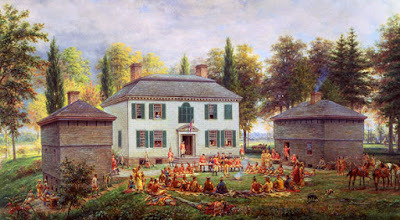 Sir William Johnson hosted Indian conferences at
Sir William Johnson hosted Indian conferences at
Johnson Hall
Indian Fighter
The younger Johnson also acquitted himself well during Pontiac’s Rebellion in 1763, when he led a successful expedition into the Ohio territory. Two years later his father sent him to England to broaden his horizons and establish him as a man of means and social standing. The journey had the desired result and Johnson was knighted by King George III in preparation of inheriting his father’s impressive estates in America.
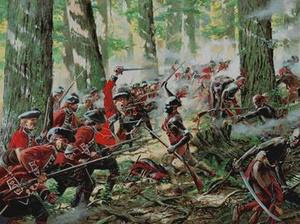 The younger Johnson distinguished
The younger Johnson distinguished
himself during Pontiac's Rebellion
Gentleman Farmer
Johnson returned from Britain a staunch supporter of the crown, and disdained all who dared disagree with royal policies. He settled at Fort Johnson and took Clarissa Putman as his common-law wife. But a man of Johnson’s status needed the proper sort of match and in 1773 he finally acceded to his father’s desire for him to marry into the New York aristocracy. Johnson left Clarissa Putman, but he did provide support to her and their two children. He was now able to marry Mary Watts and brought her to Fort Johnson.
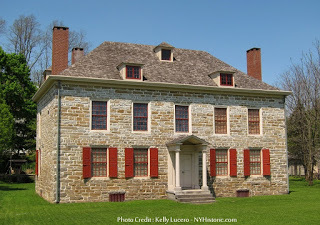 John Johnson settled in at Fort Johnson
John Johnson settled in at Fort Johnson
after inheriting the Baronetcy
The 2nd Baronet
In 1774, Sir William died. John was now the 2nd Baronet of New York and inherited over 200,000 acres along with numerous tenants. He did not, however, comply with his father’s wish to become the next superintendent of northern Indians. Instead John lived as a country gentleman in his palatial home - Johnson Hall. Due to his social standing and wartime experience Johnson was made a major general of militia not long before the outbreak of the Revolutionary War.
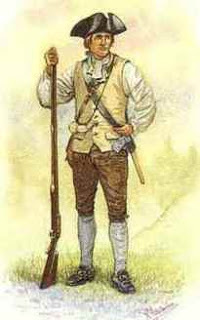 At the outbreak of war the NY
At the outbreak of war the NY
militiamen would have to choose sides
Loyalist Leader
In the run up to war, Johnson espoused Loyalist sympathies and went about recruiting from his tenants, many of whom were Scottish and English war veterans. This became a sort of personal militia. Johnson even approached the Royal Governor, William Tryon with the offer to organize the entire Mohawk Valley in support of the crown. Johnson’s actions alarmed the local patriots and when the time was right, he became a target.
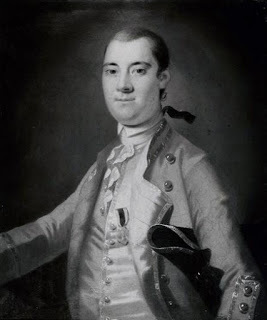 Governor William Tryon was a key
Governor William Tryon was a key
figure in the run up to the American Revolution
In January 1776 the Continental Congress authorized General Philip Schuyler, also prominent New York landholder, to gather an army and attack Johnson with the aim of eliminating the threat he and his followers posed to the Albany region. Schuyler accomplished his task. Johnson’s supporters and followers were disarmed and Johnson promised to maintain neutrality. However, the local patriots remained suspicious of his motives.
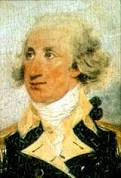 Fellow New York aristocrat led
Fellow New York aristocrat led
efforts against Johnson
A King's Commission
Tensions mounted and suspicions grew over the next several months. Fearing arrest, Johnson fled with his family and supporters to Quebec in May 1776. Johnson then offered his services to the Governor General of Canada, Guy Carleton. Carleton commissioned him a lieutenant-colonel of a newly formed unit, the King’s Royal Regiment. Johnson was ordered to leverage his connections to the Indians to keep them neutral.
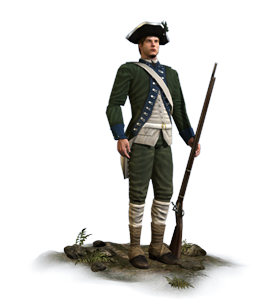 Soldier of the King's Royal Regiment
Soldier of the King's Royal Regiment
A Failed Campaign
In the summer of 1777, Johnson accompanied Lieutenant-Colonel Barry St. Leger on his expedition up the Mohawk River. This was part of a three pronged attack on Albany to control the New York waterways and divide the colonies. Johnson’s men and Indian confederates assisted Saint Leger in the siege of Fort Stanwix (today’s Rome, NY). Saint Leger got wind of a relief column marching west to relieve the siege. This force of patriot militia force was led by Colonel Nicholas Herkimer. Johnson’s Indian allies found the perfect ambush spot near Oriskany and on 6 August a combined Indian –Loyalist force defeated Herkimer, who was mortally wounded.
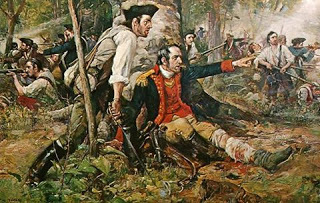 The Battle of Oriskany
The Battle of Oriskany
But when word of another relief column, this time led by Benedict Arnold reached them, Saint Lager’s forces retreated back to Canada and Johnson went with him. In no small irony, the man who eschewed replacing his father as Indian Superintendent wound up devoting much of his time handling Indian affairs for the British as many hundreds had fled their lands to avoid the ravages of the American settlers.
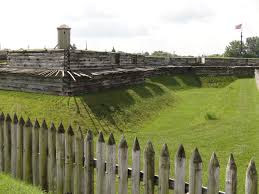 The failed siege of Fort Stanwix was
The failed siege of Fort Stanwix was
a foretaste of the failed British strategy to split the colonies
Guerilla Warrior
But Johnson also found time to wage an on and off again guerrilla war in central New York. Over the next three years he became infamous in the Mohawk Valley region for his raids of combined Loyalist and Indian forces. Johnson often teamed with Loyalist Colonel John Butler and Loyalist Iroquois Chief Joseph Brant. This dream team of crown supporting bad asses raised havoc.
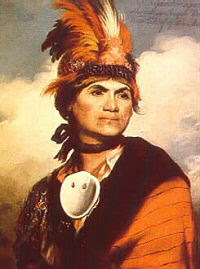 Chief Joseph Brant was a key ally
Chief Joseph Brant was a key ally
of Johnson and tireless fighter for the
Iroquois and the crown
Perhaps his greatest success came in 1780 when Johnson’s strike force pillaged and burned settlements at Schoharie, Caughnawaga and Fort Hunter. He even managed to retake his homestead, Johnson Hall. Johnson’s guerrilla actions caused great economic hardship and depleted the morale of the American settlers in the region. But overall they failed to influence the war to any great extent.
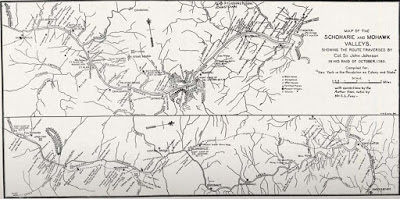 Johnson's Raid was his major operation but in the
Johnson's Raid was his major operation but in the
end, the mix of Loyalists and Iroquois could not
hold central New York
Superintendent General
In 1782 Governor General Frederick Haldimand appointed Johnson brigadier-general on the American establishment and, by a commission dated 14 March 1782, named him Superintendent General and Inspector General of the Six Nations Indians and those in the Province of Quebec. In taking this appointment he replaced his cousin Guy Johnson, who was removed for fiscal irregularities. This was no easy job. The war was ending badly, and not just for the Loyalists who were driven to Canada. Johnson had to explain to the disgruntled Iroquois that much of their land was being turned over to the Americans.
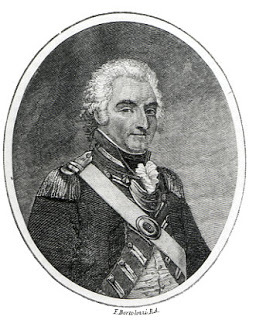 Johnson would not receive the one
Johnson would not receive the one
appointment he wanted in later life
A Canadian Founder
After the war, Johnson travelled back to England as so many Loyalists did to make claims for compensation to the crown. Upon his return to Canada he was a leader in resettling Loyalists and Indians at Cataraqui (today’s Kingston, ON). He did outstanding work for the refugees to the point where he thought he would get the first appointment as governor general of the new province of Upper Canada. When the appointment went to that other Loyalist bad ass, John Graves Simcoe, Johnson was devastated.
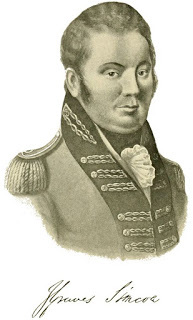 Loyalist leader John Graves Simcoe would
Loyalist leader John Graves Simcoe would
receive the appointment Johnson hoped for
After spending a few more years in England, Johnson settled in Quebec, gaining an appointment to the Legislative Council of Lower Canada. He became prominent among the United Empire Loyalists and a defender of Indian rights.
A Last Tribute
Sir John Johnson died in Montreal on 4 January 1830. Johnson is considered one of the founding fathers of Canada. He had a military funeral, which was attended by throngs of friends, relatives, acquaintances, and admirers. In addition, more than 300 Indians attended and Chief Joseph Brant gave the eulogy. At the ceremony Brant referred to him as the Indians’ “friend and fellow warrior.” Sir John's body was then taken to Mount Johnson for burial.
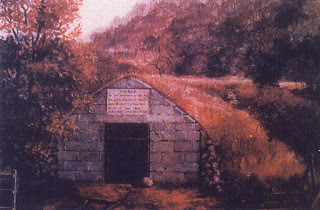 Sir John was interred in a family vault
Sir John was interred in a family vault
at Mount Johnson
It is somewhat rare to run back to back profiles of Loyalists but I have been meaning to profile a member of a family that defined British – native relations in the mid to late 18th century, Sir John Johnson. John Johnson's father was the famed Agent of the crown to the Indians of New York. In that capacity, Sir William Johnson, 1st Baronet of New York, was the key interlocutor for British interests and managed to establish pretty good relations between the settlers and the Iroquois nations in central New York. This was no easy undertaking as the migrants from New England and other points east had a thirst for land and the Iroquois had a thirst for, well suffice to say they were the most fearsome warriors of their day and not to be trifled with. William Johnson’s passing and the outbreak of the American Revolution ignited a final struggle between these forces.
 Sir William Johnson, 1st Baronet of New York
Sir William Johnson, 1st Baronet of New YorkThrust into this frontier cauldron was Johnson’s heir and reluctant interlocutor, John Johnson, 2nd Baronet of New York. The younger Johnson was born 5 Nov. 1741 at Mount Johnson near New Amsterdam, New York. His mother was a local woman of Dutch extraction, Catherine Wysenberk.
 Sir John Johnson, 2nd Baronet
Sir John Johnson, 2nd BaronetFrench & Indian Fighter
John Johnson spent most of his childhood at Fort Johnson on the Mohawk River. After briefly attending Benjamin Franklin’s College and Academy in Philadelphia in 1757, Johnson returned home to answer the call of the war drums. So at the age of 13 Johnson accompanied his father as a volunteer in the French and Indian War. He accompanied him on expeditions to Niagara and Detroit. He also attended most of Sir William’s conferences with the Indians, including the one at Fort Stanwix (Rome), N.Y., in 1768 that established the boundary between encroaching white settlers and the Iroquois.
 Sir William Johnson hosted Indian conferences at
Sir William Johnson hosted Indian conferences atJohnson Hall
Indian Fighter
The younger Johnson also acquitted himself well during Pontiac’s Rebellion in 1763, when he led a successful expedition into the Ohio territory. Two years later his father sent him to England to broaden his horizons and establish him as a man of means and social standing. The journey had the desired result and Johnson was knighted by King George III in preparation of inheriting his father’s impressive estates in America.
 The younger Johnson distinguished
The younger Johnson distinguishedhimself during Pontiac's Rebellion
Gentleman Farmer
Johnson returned from Britain a staunch supporter of the crown, and disdained all who dared disagree with royal policies. He settled at Fort Johnson and took Clarissa Putman as his common-law wife. But a man of Johnson’s status needed the proper sort of match and in 1773 he finally acceded to his father’s desire for him to marry into the New York aristocracy. Johnson left Clarissa Putman, but he did provide support to her and their two children. He was now able to marry Mary Watts and brought her to Fort Johnson.
 John Johnson settled in at Fort Johnson
John Johnson settled in at Fort Johnsonafter inheriting the Baronetcy
The 2nd Baronet
In 1774, Sir William died. John was now the 2nd Baronet of New York and inherited over 200,000 acres along with numerous tenants. He did not, however, comply with his father’s wish to become the next superintendent of northern Indians. Instead John lived as a country gentleman in his palatial home - Johnson Hall. Due to his social standing and wartime experience Johnson was made a major general of militia not long before the outbreak of the Revolutionary War.
 At the outbreak of war the NY
At the outbreak of war the NYmilitiamen would have to choose sides
Loyalist Leader
In the run up to war, Johnson espoused Loyalist sympathies and went about recruiting from his tenants, many of whom were Scottish and English war veterans. This became a sort of personal militia. Johnson even approached the Royal Governor, William Tryon with the offer to organize the entire Mohawk Valley in support of the crown. Johnson’s actions alarmed the local patriots and when the time was right, he became a target.
 Governor William Tryon was a key
Governor William Tryon was a keyfigure in the run up to the American Revolution
In January 1776 the Continental Congress authorized General Philip Schuyler, also prominent New York landholder, to gather an army and attack Johnson with the aim of eliminating the threat he and his followers posed to the Albany region. Schuyler accomplished his task. Johnson’s supporters and followers were disarmed and Johnson promised to maintain neutrality. However, the local patriots remained suspicious of his motives.
 Fellow New York aristocrat led
Fellow New York aristocrat ledefforts against Johnson
A King's Commission
Tensions mounted and suspicions grew over the next several months. Fearing arrest, Johnson fled with his family and supporters to Quebec in May 1776. Johnson then offered his services to the Governor General of Canada, Guy Carleton. Carleton commissioned him a lieutenant-colonel of a newly formed unit, the King’s Royal Regiment. Johnson was ordered to leverage his connections to the Indians to keep them neutral.
 Soldier of the King's Royal Regiment
Soldier of the King's Royal RegimentA Failed Campaign
In the summer of 1777, Johnson accompanied Lieutenant-Colonel Barry St. Leger on his expedition up the Mohawk River. This was part of a three pronged attack on Albany to control the New York waterways and divide the colonies. Johnson’s men and Indian confederates assisted Saint Leger in the siege of Fort Stanwix (today’s Rome, NY). Saint Leger got wind of a relief column marching west to relieve the siege. This force of patriot militia force was led by Colonel Nicholas Herkimer. Johnson’s Indian allies found the perfect ambush spot near Oriskany and on 6 August a combined Indian –Loyalist force defeated Herkimer, who was mortally wounded.
 The Battle of Oriskany
The Battle of OriskanyBut when word of another relief column, this time led by Benedict Arnold reached them, Saint Lager’s forces retreated back to Canada and Johnson went with him. In no small irony, the man who eschewed replacing his father as Indian Superintendent wound up devoting much of his time handling Indian affairs for the British as many hundreds had fled their lands to avoid the ravages of the American settlers.
 The failed siege of Fort Stanwix was
The failed siege of Fort Stanwix wasa foretaste of the failed British strategy to split the colonies
Guerilla Warrior
But Johnson also found time to wage an on and off again guerrilla war in central New York. Over the next three years he became infamous in the Mohawk Valley region for his raids of combined Loyalist and Indian forces. Johnson often teamed with Loyalist Colonel John Butler and Loyalist Iroquois Chief Joseph Brant. This dream team of crown supporting bad asses raised havoc.
 Chief Joseph Brant was a key ally
Chief Joseph Brant was a key allyof Johnson and tireless fighter for the
Iroquois and the crown
Perhaps his greatest success came in 1780 when Johnson’s strike force pillaged and burned settlements at Schoharie, Caughnawaga and Fort Hunter. He even managed to retake his homestead, Johnson Hall. Johnson’s guerrilla actions caused great economic hardship and depleted the morale of the American settlers in the region. But overall they failed to influence the war to any great extent.
 Johnson's Raid was his major operation but in the
Johnson's Raid was his major operation but in theend, the mix of Loyalists and Iroquois could not
hold central New York
Superintendent General
In 1782 Governor General Frederick Haldimand appointed Johnson brigadier-general on the American establishment and, by a commission dated 14 March 1782, named him Superintendent General and Inspector General of the Six Nations Indians and those in the Province of Quebec. In taking this appointment he replaced his cousin Guy Johnson, who was removed for fiscal irregularities. This was no easy job. The war was ending badly, and not just for the Loyalists who were driven to Canada. Johnson had to explain to the disgruntled Iroquois that much of their land was being turned over to the Americans.
 Johnson would not receive the one
Johnson would not receive the oneappointment he wanted in later life
A Canadian Founder
After the war, Johnson travelled back to England as so many Loyalists did to make claims for compensation to the crown. Upon his return to Canada he was a leader in resettling Loyalists and Indians at Cataraqui (today’s Kingston, ON). He did outstanding work for the refugees to the point where he thought he would get the first appointment as governor general of the new province of Upper Canada. When the appointment went to that other Loyalist bad ass, John Graves Simcoe, Johnson was devastated.
 Loyalist leader John Graves Simcoe would
Loyalist leader John Graves Simcoe wouldreceive the appointment Johnson hoped for
After spending a few more years in England, Johnson settled in Quebec, gaining an appointment to the Legislative Council of Lower Canada. He became prominent among the United Empire Loyalists and a defender of Indian rights.
A Last Tribute
Sir John Johnson died in Montreal on 4 January 1830. Johnson is considered one of the founding fathers of Canada. He had a military funeral, which was attended by throngs of friends, relatives, acquaintances, and admirers. In addition, more than 300 Indians attended and Chief Joseph Brant gave the eulogy. At the ceremony Brant referred to him as the Indians’ “friend and fellow warrior.” Sir John's body was then taken to Mount Johnson for burial.
 Sir John was interred in a family vault
Sir John was interred in a family vaultat Mount Johnson
Published on June 02, 2019 11:25



